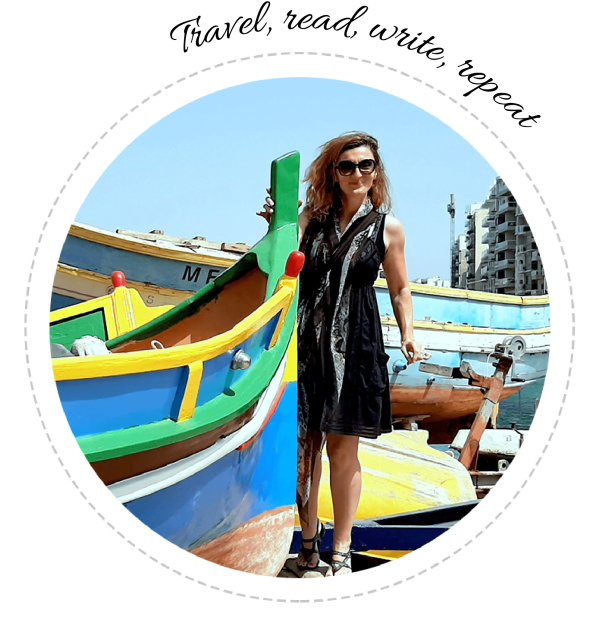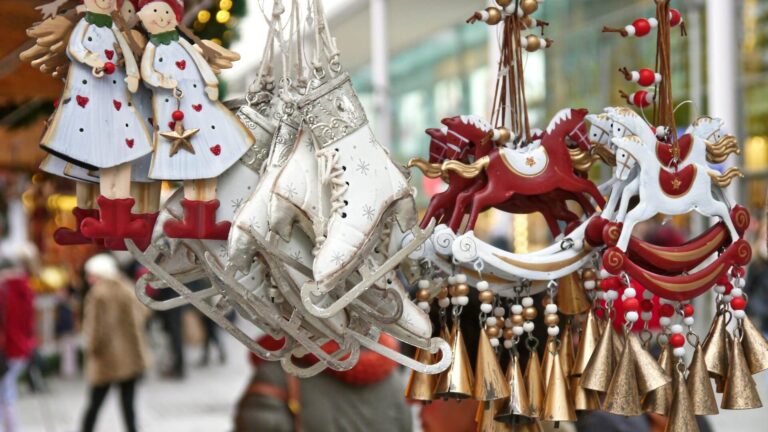
If you need a freelance travel writer or you would like to see your country, city, flight, etc., presented on the blog, drop me an email.
Find our more on Freelance Travel Writer page.
I am writing this post about Corfu island in Greece right after I came back. If you love Italy and gladly travel to Greece, expect lovely beaches but also something new to see and try, Corfu island in Greece is the perfect place. And yes, this is not just another summer resort in Greece. And here is why.
Corfu Greece
Corfu Greece is the most northern island in the Ionian Sea known to be ruled by the Venetian Republic (like most of the Ionian islands) for four centuries while the rest of Greece and the Balkans were under the control of the Ottomans. The island was invaded by the French and the English soon after, only to become a part of Greece in 1864. This is the reason you will find a significant architectural legacy of these nations along with their influence on food. For example, some of the traditional Greek dishes are eaten here with an addition of Italian pasta and the British ginger ale is also popular. There are four million olive trees on the island first planted by the Venetians. Tourists from Britain and Italy dominate the island resorts while there are also numerous people visiting from France, Spain, and northern Europe.
We mainly flock to Corfu during summer because of its beaches and some Great War connoisseurs tend to visit the Serbian Museum and a tinny Vido Island due to its historical significance.
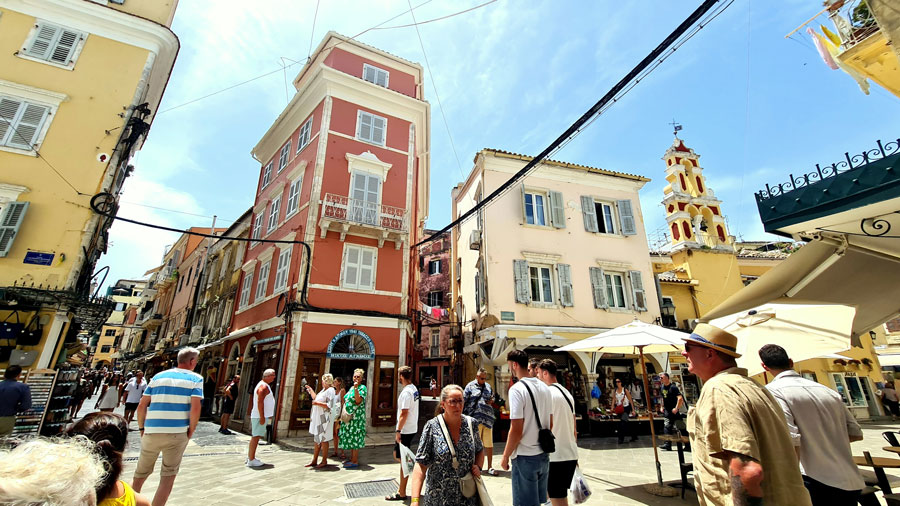
The post about Corfu island in Greece will therefore include its landmarks and numerous beaches, in other words – all the things I managed to do and see for myself. You might wonder if it could all be done in one go but if I could do it, so can you. Further down you will find information about which area is best to stay and car rental but first, these are the Corfu island things to do.
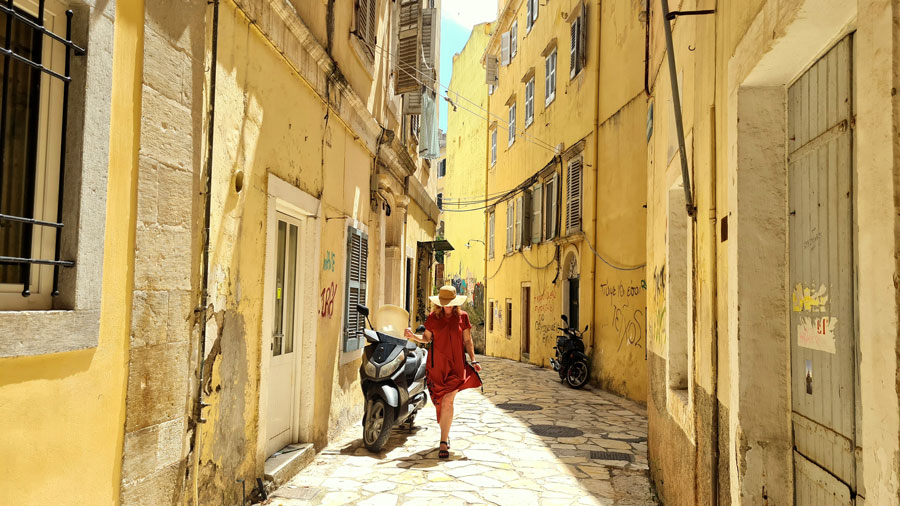
Old Town in the Corfu capital (or Kerkyra as Greeks call it) is one of those places I didn’t mind getting lost in. There are narrow alleys, lovely archways, charming Venetian villas with lots of restaurants and bars, the smell of cheese pies (Tiropita) and ice cream, souvenir shops, and old facades that get you mesmerized all at once. Different languages and bustling atmosphere with seagulls croaking in the background add to its enchanting ambiance.
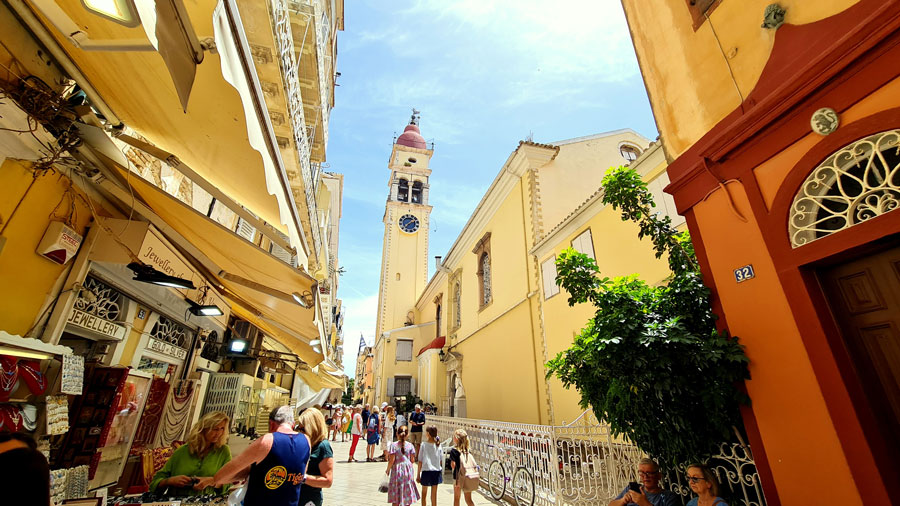
Almost all the landmarks one should see are situated in the Old Town of the Corfu island in Greece. Among others: Old and New Fortress, both built by the Venetians in the 16th century; Saint Spyridon Church that houses relics of the saint who attended the First Ecumenical Council in 325 AD and whose remains were brought by Greek monks after the invasion of Constantinople by the Ottomans in 1453; Spianada Square (the largest in Greece); St Michael and St George’s Palace (erected by the British in 1819 for the Ionian Parliament that now houses the local Museum of Asian Arts); Liston Palace (built by the French at the beginning of the 19th century with typical arches and cafés); Town Hall (which used to serve as San Giacomo Theater), etc.
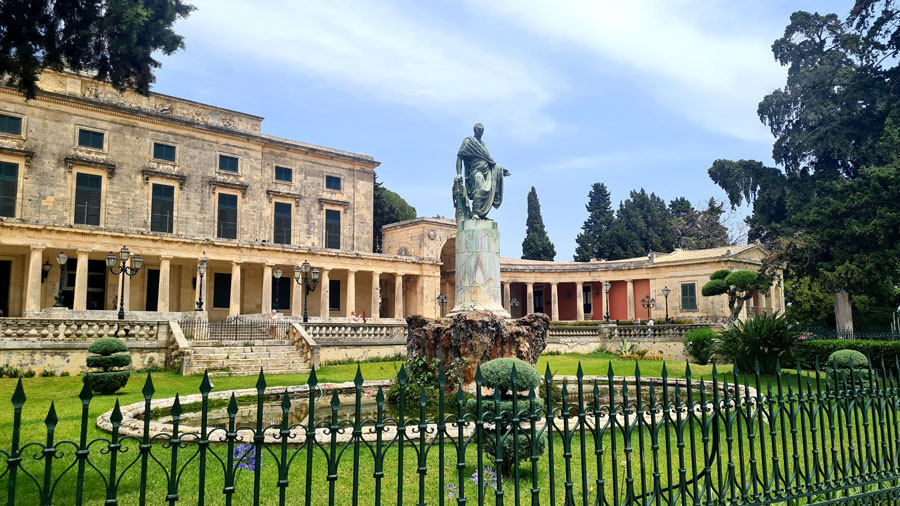
TIP: If you are coming by car from other parts of the island, go to the parking lots not far from the center. I chose one next to New Fortress (just go through the fort and you come out at the edge of Old Town) costing €7 for the whole day. It is worth it given how busy the narrow streets are and the time you need to wait in central parking areas.
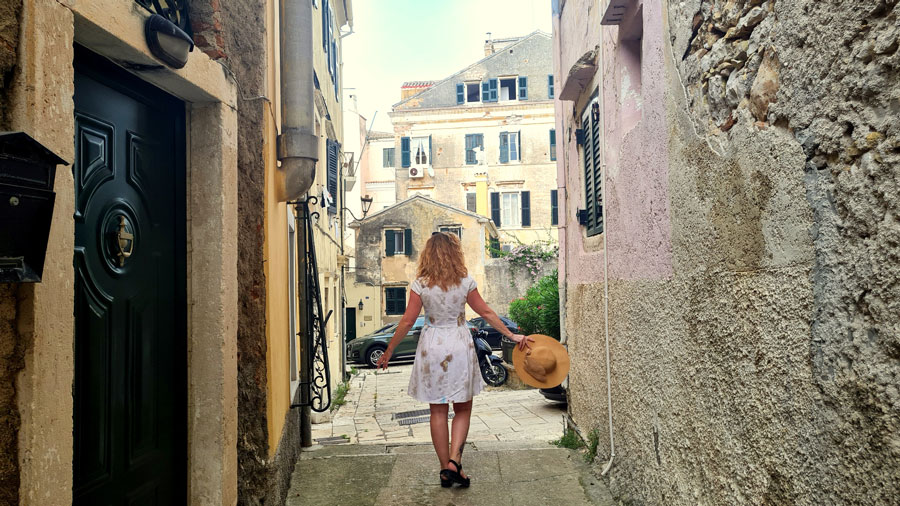
Let me say once more, Corfu island in Greece is the place to enjoy strolling around with all the senses and sounds, especially passing by old villas that will take you back to some olden times when Venetian merchants used to walk through here and pretty Italian ladies used to glance from their balconies. Don’t miss visiting the Kanoni neighborhood a few kilometers to the south where you can have a coffee on the hill overlooking the famous Vlacherna Monastery. This 17th-century church was built on a small island that can be reached via a narrow bridge (but you can’t stay long). Vlacherna is almost regarded as a symbol of Corfu. Legend has it that the island behind Vlacherna was the Odysseus’ boat which was turned into a rock by Poseidon.

History buffs and Serbs trying to discover more about their heritage will stop by the Serbian Museum dedicated to WWI events. More than 150,000 Serbian soldiers along with the Serbian government members and refugees flocked to Corfu in 1916 which had a population of 80,000. Lots of newcomers were recovering after a tough hike over the freezing mountains of Albania and Montenegro continuing their journey to the Salonica Front afterward and fighting alongside Allied Powers armies. Nevertheless, thousands of them died and were buried in the sea around the island of Vido.
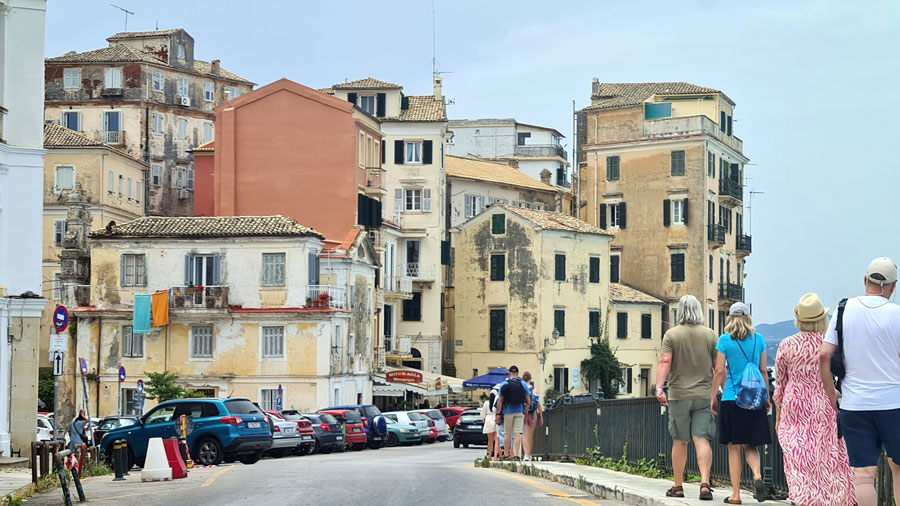
TIP: First go to the museum and then Vido (by boat from the old harbor). The museum curator will explain where else on the island one can find memorials to these WWI happenings.
All of this, of course, you can explore on your own, which is what I prefer, or you can join one of the local tours. If you go with a guide, not only will they take you to some hidden spots you won’t have to find yourself with navigation, but you’ll also hear insights from other tourists who are on Corfu for the same reasons as you. (Click above for more information.)
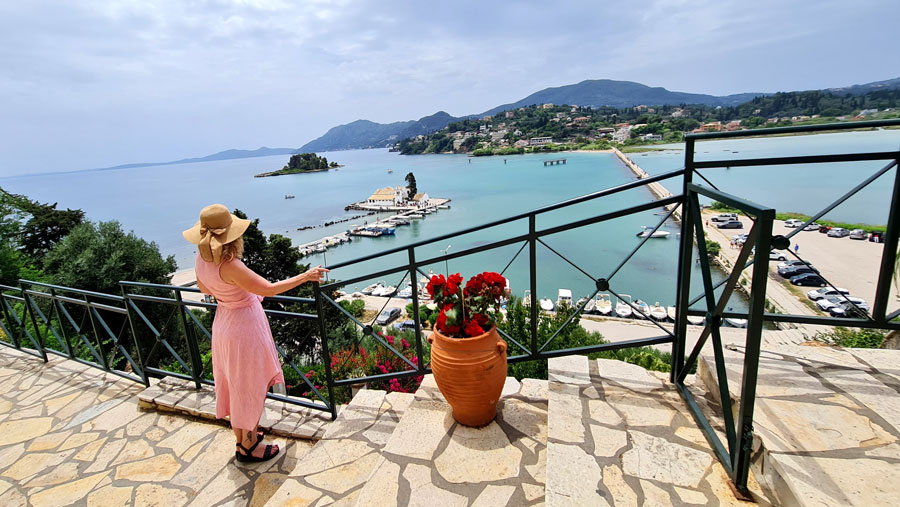
A visit to the Corfu island in Greece can’t be complete without seeing Achilleion Palace. Even though it was closed for visits due to restoration when I was there, its gardens shouldn’t be missed. The palace was built for the Empress Elizabeth of Austria, better known as Sisi, in 1890. It is situated about 10 kilometers south of the capital.
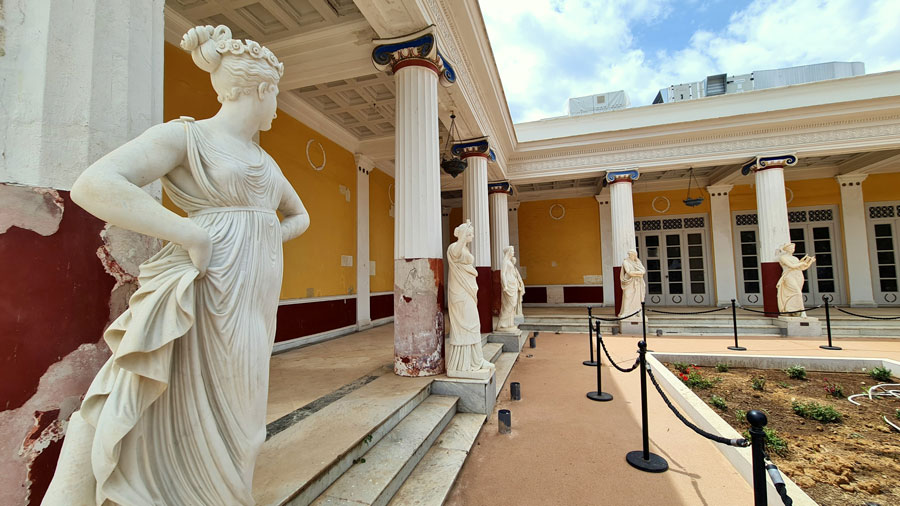
The enterance fee is €5 and you can enjoy the view of the hills with cypresses reminding you of Italy and statues of carefully chosen Greek gods and heroes. Among others, the most famous Wounded Achilles who died in the Trojan War being struck in the foot, the only vulnerable spot in his body. (This reminds me of my other journey when I visited the Acheron River where, as legend has it, Achilles’ mother used to dip him while holding him by the heel so that he can become invincible. This is why heel hill was the only weak spot.)
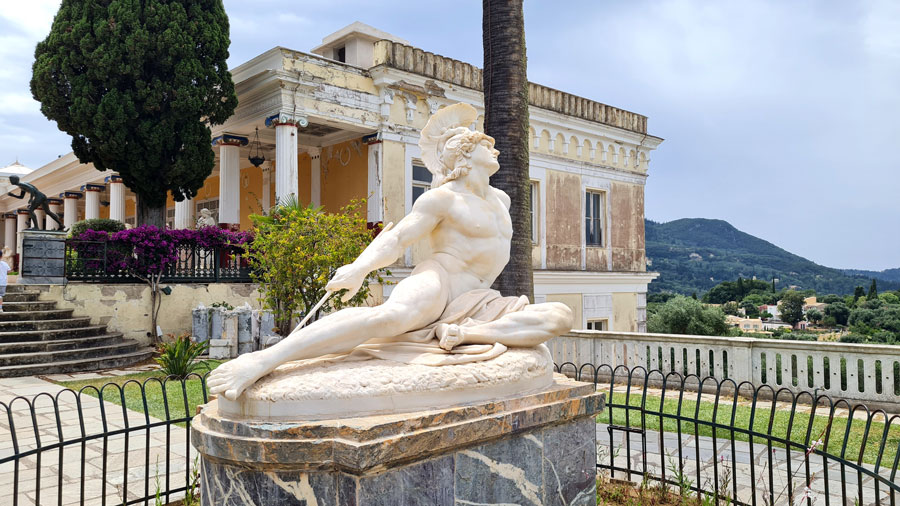
TIP: There is a small café/souvenir shop in front of the palace to have coffee or Greek pie, go to the toilet, etc. and it has a stunning view of the surrounding hills. The winery is also across the street if you are up for a glass.

You can combine your Angelokastro visit with swimming at some of the surrounding beaches on the western coast of Corfu island in Greece. The castle is located near Paleokastritsa (with the most popular beach). The ticket is €3 and one should climb 172 stone steps to get to the clifftop with the 12th-century ruins. (How they managed to build this nine centuries ago, I still cannot grasp!)
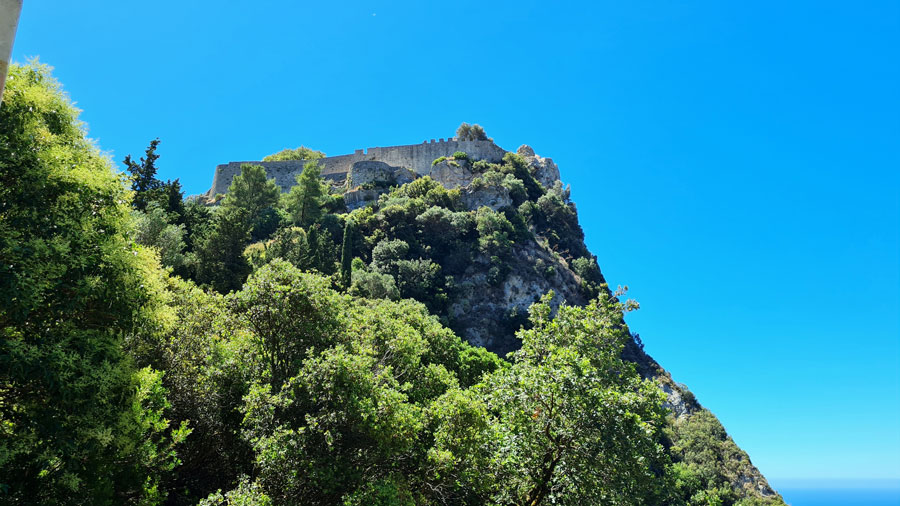
TIP: Try not to wear anything that can make you slip like flip-flops and don’t experiment much with climbing slippery rocks on the way. Keep to the marked pathways, this will do the trick. And don’t forget to bring water.
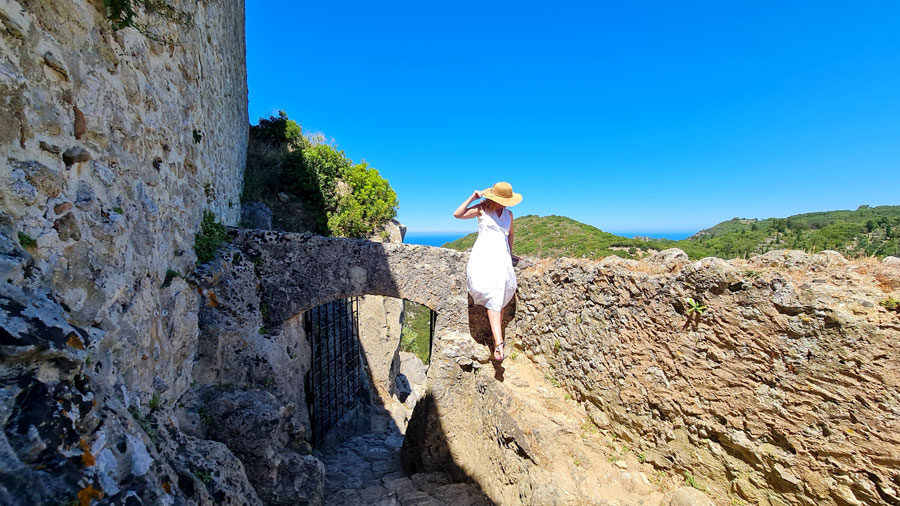
Even though it’s not that high, the clifftop is steep enough to offer a breathtaking view of the Paleokastritsa Monastery and its beach on one side, and the sea horizon on the other. At the very top, there is an old church made of stone and an olive tree shade to rest in. Beneath the fortress, a restaurant can be found for those who seek to freshen up before continuing with exploring the Corfu island of Greece.
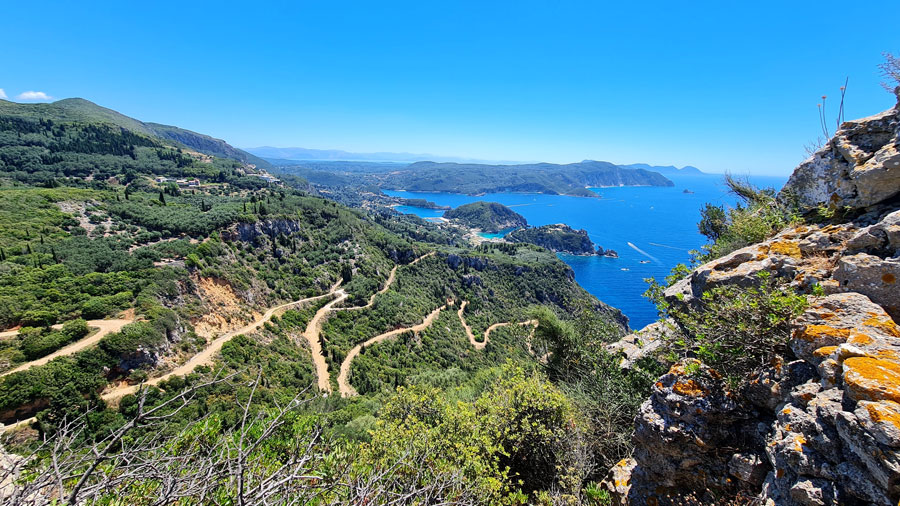
On the hill above the Paleokastritsa beach (or the cove of Saint Spyridon) the Byzantine monastery complex dedicated to Virgin Mary and established at the beginning of the 13th century is nestled. The Genoese and the Ottomans destroyed it in the 15th and the 16th century. Its current look and monks’ cells originate from the 18th century. Notice the old 17th and 18th-century frescoes and bones of a whale which are also housed at the monastery museum.
They say that Paleokastritsa means “an old castle” in Greek.
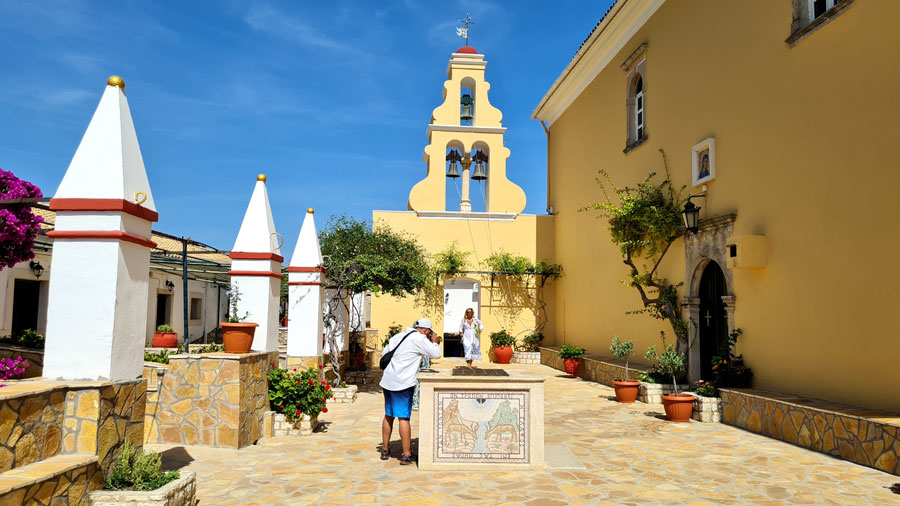
A quiet complex is abundant in greenery and flowers. Enjoy a stroll, a shade on the bench, and a great view of the sea. Candles can be bought in the church. They are not sold and you should thus prepare coins since you choose how much to give in return.
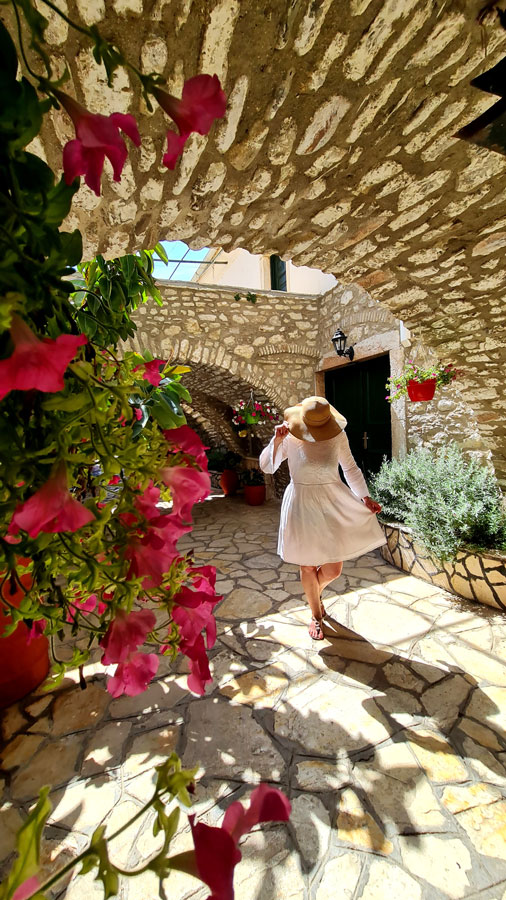
TIP: Next to the altar there are pieces of paper to write the names of the living or deceased relatives so that they can be mentioned during the church service. Hand them over to the guy at the entrance.
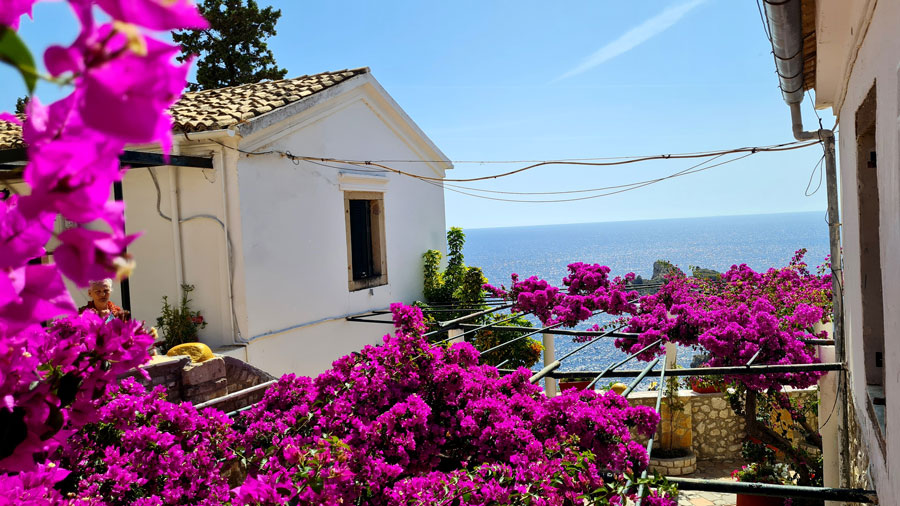
Old Perithia is the oldest village on Corfu Island in Greece. This is where Venetians decided to build a settlement to move further away from the coast due to pirate raids. That is why the village is situated so high up on the slopes of Pantokrator Mountain (which holds the highest peak of Corfu of 906 meters) overlooking the sea without being seen by the intruders from below.
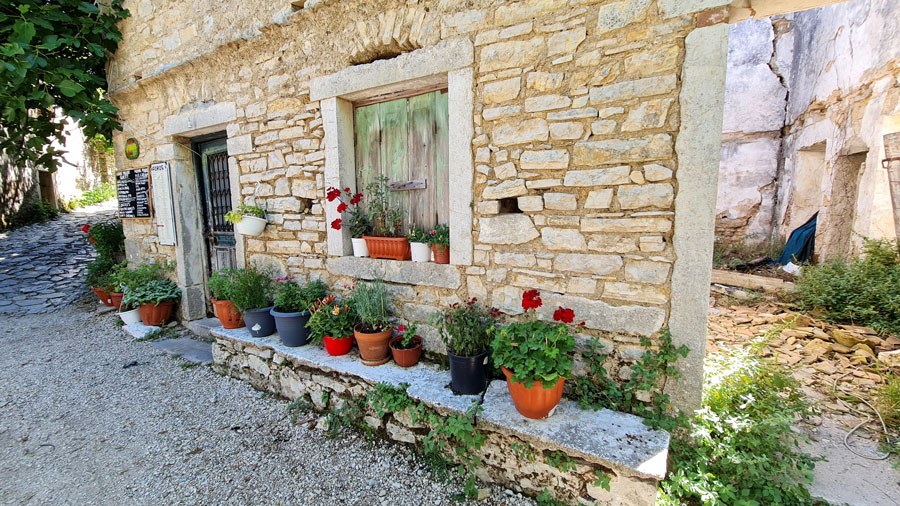
It was deserted for centuries when nature took over coating old Venetian stone walls in a tight grip. The village woke up in 2010 when a couple of Britons restored three houses and opened an accommodation. A few taverns were established afterward to catch a breath in after exploring the village in the hot Corfu weather.
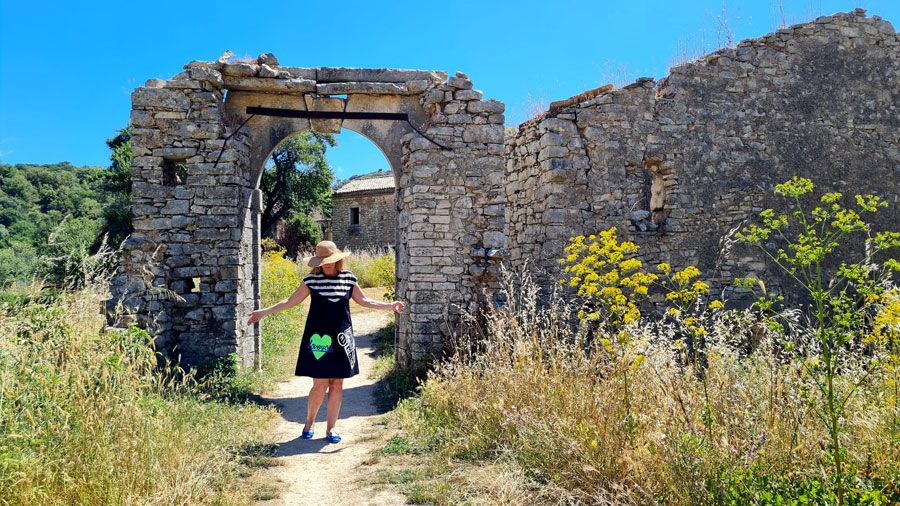
TIP: The village is an inspiration for taking pictures (one can see the sky through those old walls). If you stroll around the central area, you won’t need more than half an hour. On the other hand, if you want to visit the nearby (new) village or try to find some local honey produced in the same manner for generations, you will need a couple of hours more.

This village is interesting mostly to people from Great Britain because of the author Gerard Durrell or if you are a fan of The Durrells series. The author lived on Corfu with his family and dedicated some of his work to the island. Danilia is actually the replica of a Corfu traditional village from the 1930s and belongs to the hotel which rented it for organizing traditional celebrations. Then came filming scenes for one of James Bond’s movies For Your Eyes Only and the series I mentioned above.
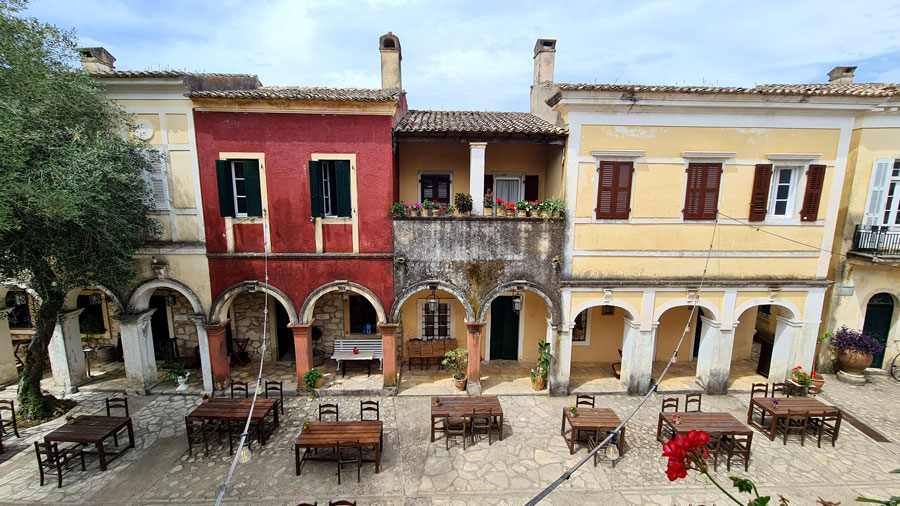
The village is not big and is easy to find. The entrance fee is €10 with a drink included. This is a great opportunity to have a local ginger ale with Kumquat flavor (more about it in the What to Try in Corfu section). Stoll around, take pictures of colorful façades, and peak into displayed houses and replicas of oil manufacturing premises but don’t miss visiting the museum on the first floor with the 19th and 20th-century traditional items and furniture.
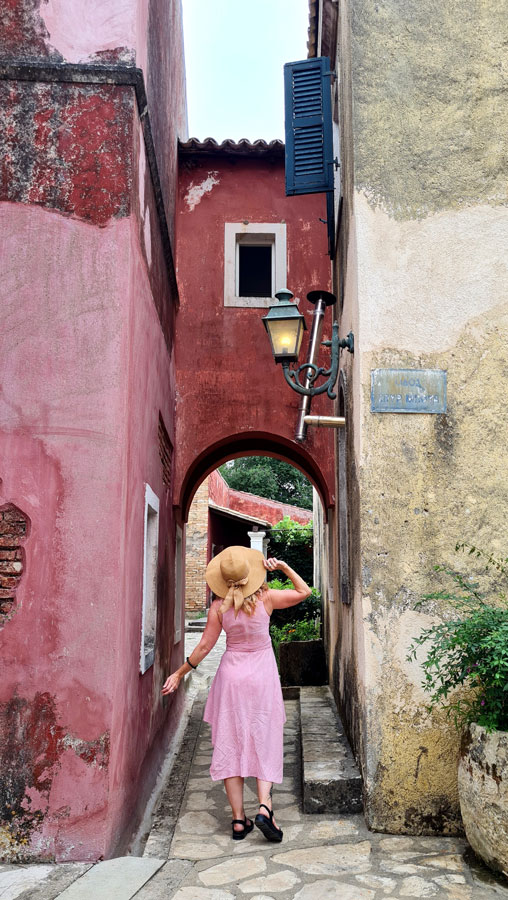
Even though it is one of the largest settlements in the south of Corfu Island in Greece, Lefkimmi is not that developed. I came to see the popular canal cutting the town in two which is why Lefkimmi was nicknamed Greece’s Venice. The river goes through the canal (the only river in Corfu) flowing into the sea after about 1.5 km. This is where the Buka beach is situated (Buka stands for river in Greek).
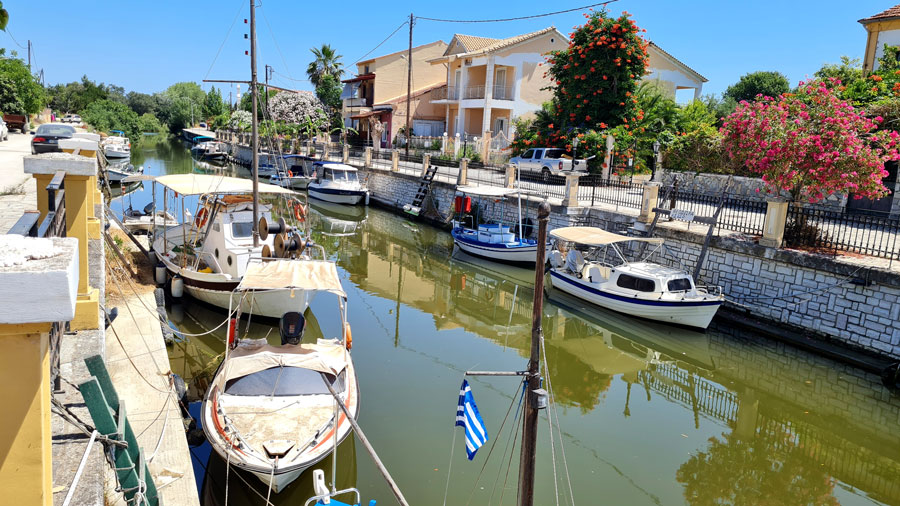
They say that Lefkimmi inhabitants originally come from Corfiot ancestors and not Greeks who came from Crete and other parts of the country. Since the place is not developed, you will notice many neglected houses and quiet small streets. Still, the thing you came for is worth a visit. Pick a restaurant on either side of the canal full of flowers and have refreshments or snacks. Prices are lower than expected.
TIP: You can park alongside the canal. The place is not crowded. If you rely on navigation apps, make sure to type in Lefkimmi Bridge and not the town itself since there is no need to drive around.
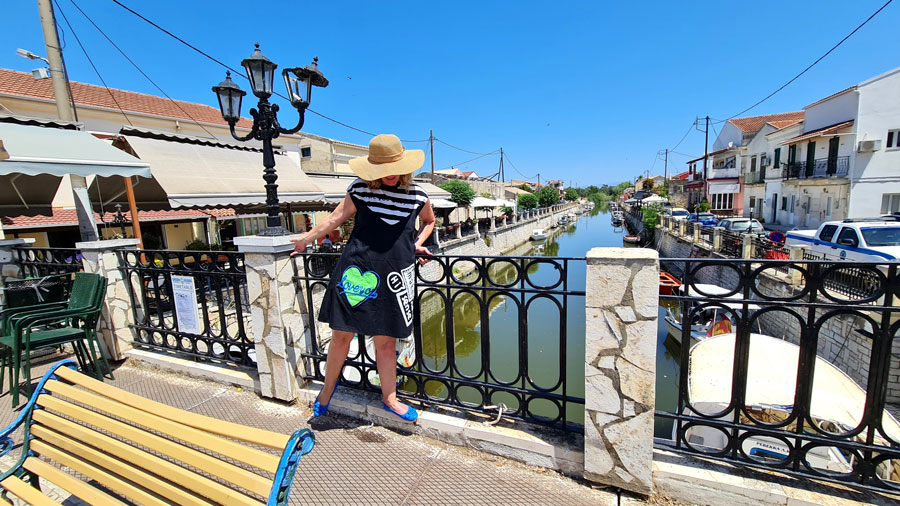
Wherever you drive around the island, you will go through some remote villages adorning the hill slopes. Some of them are vibrant and settled while most seem deserted and neglected. But, on your way to Porto Timoni viewpoint, the road goes to Afionas village where you will also find a parking lot (€5 for the whole day).
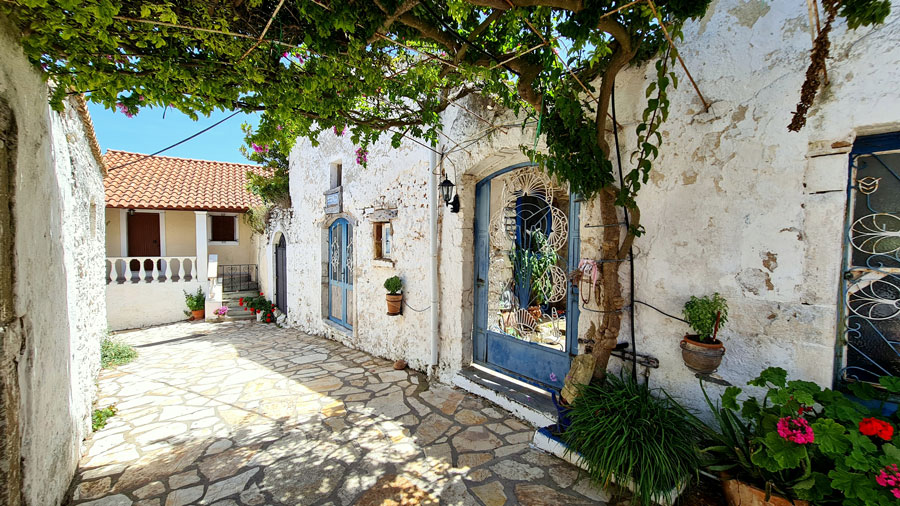
This is a good opportunity to stroll around the settlement high up on the slopes decorated with colorful old villas, lovely backyards, lush flowers, and a couple of souvenir shops. Afionas is one of the oldest villages in the northwest part of Corfu Island in Greece. Even though it occupies the area at an altitude of only 133 meters, it seems much higher due to the steepness of the hill. When you go through the settlement, there will be a viewing platform and an improvised café. This is where the goat trail starts which will (after a 20 minute hike) take you to the rock with a stunning Porto Timoni view or the beach itself.
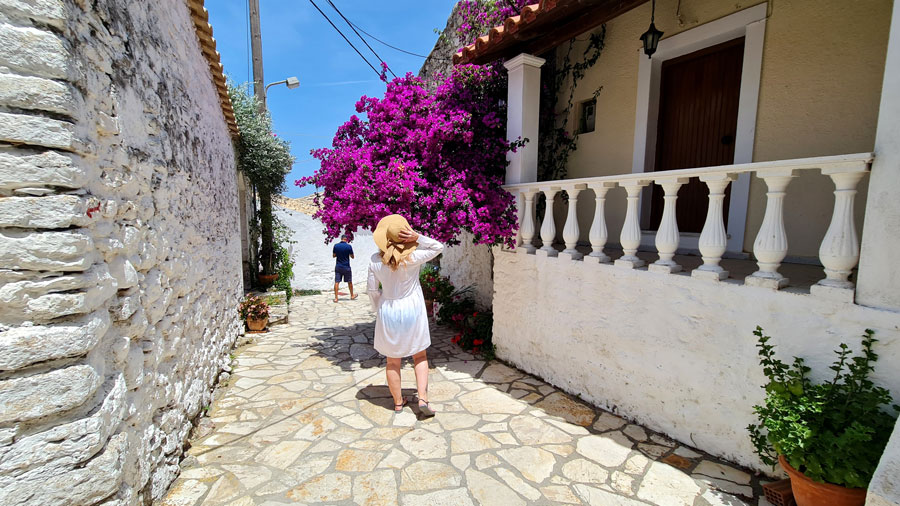
Beaches in Corfu island in Greece are a must. That is why a large portion of the post is dedicated to Corfu beaches but only those that I visited (and there are so many more). It is important to say that you will most certainly find a beach according to your liking given how diverse they are. They range from sandy, quiet, shallow, pebbly, windy, cold, long, small, rocky, deep, and equipped with everything, to the wild. The only question is how much time you have and how willing you are to explore since some of them are not that easy to reach. Take Katevasidi and Loggas beaches. They say they should be visited because of the sunset but sunsets are beautiful at any beach in the west. Katevasidi takes a bit of walking via a dirt road and an improvised steep trail made of clay which can get very slippery. Both of the beaches are wild with yellowish sand against the white cliffs, and empty.
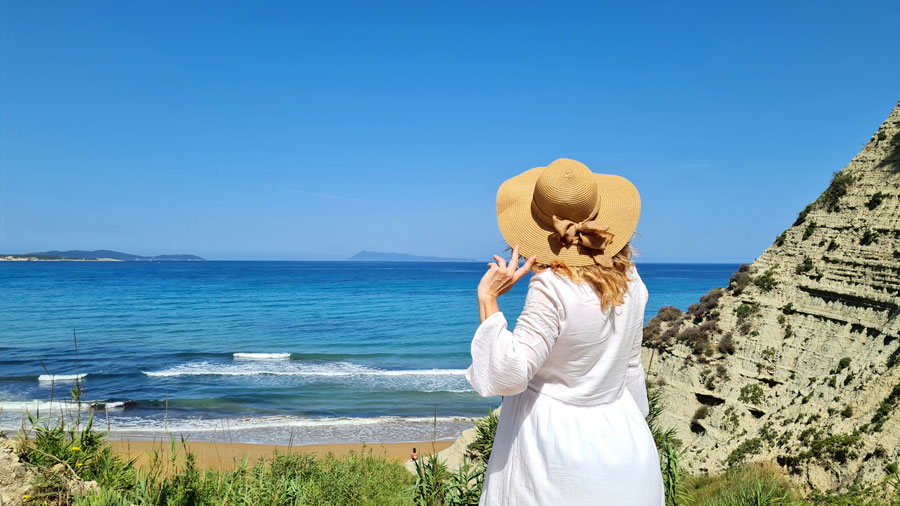
Another important thing: there is the northwestern wind typical for Corfu which enables day-to-day waves that craft those lovely white cliffs in the north. So, if you are visiting one of the southern beaches, you can expect frequent waves or seaweed on the shore or just a bit colder water than in other parts of Corfu Island in Greece. The northern coast is adorned with cliffs and pebbles which become smaller toward Dasia in the east. This side of the island is mostly sandy and quiet toward the south with shallow water perfect for kids and the elderly.
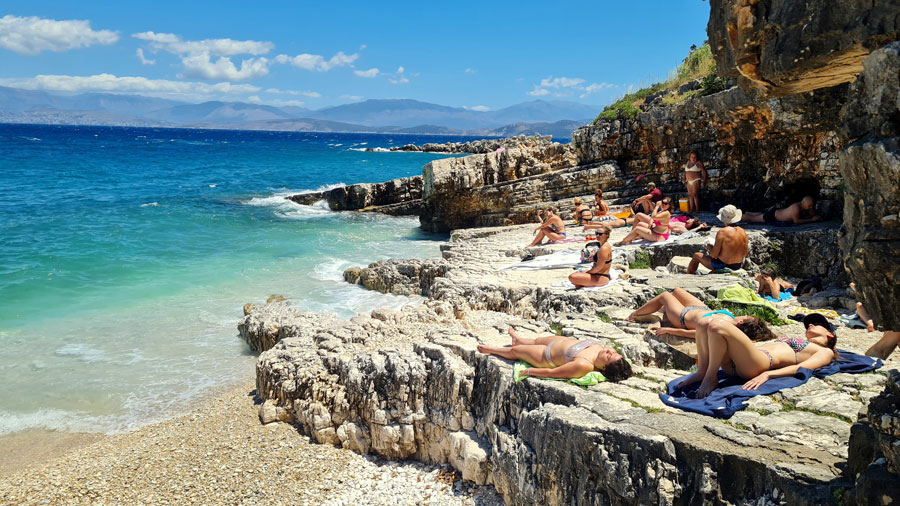
(the west coast, from north to south)
This is one of the landmarks of Corfu Island in Greece rather than a place to come for a swim. Legend has it, if you swim in the Channel of Love with your current partner, you will stay together forever. Singles should swim and touch both sides of the channel and, who knows, may return in a couple from Corfu.
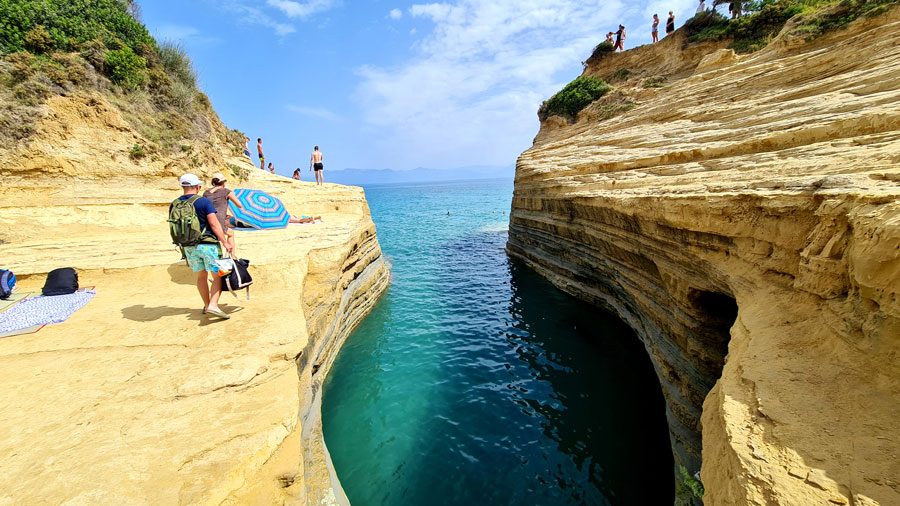
Joking aside, Canal D’Amour is a cut through the cliffs created by nature. Right next to the rocks, there is a small sandy beach to get wet easily (if you don’t fancy a cliff jump) and one can even swim through small caves to the canal itself. This is also a nice experience. Don’t skip putting the clay from the cliffs’ surface onto your skin since it should be beneficial. When it dries, jump back to sea and rinse it.
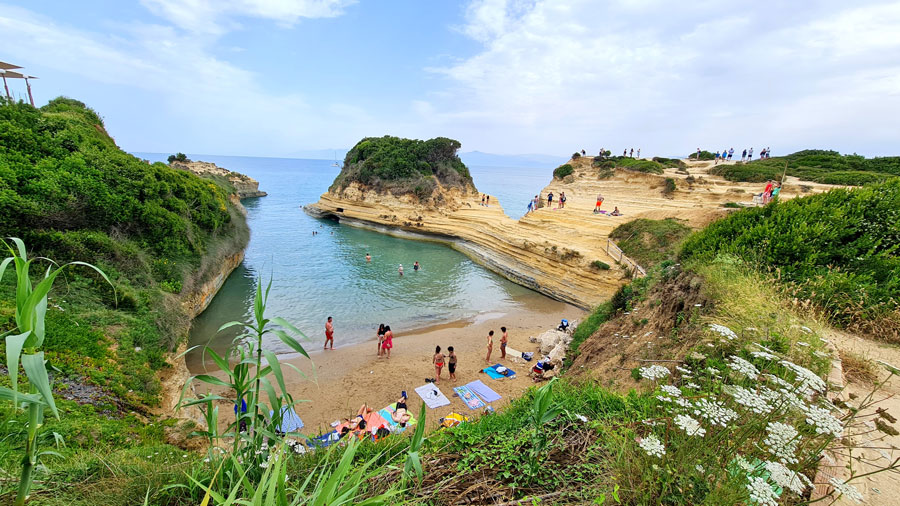
TIP: If you have enough time, take a walk along the coast to the east since there is a bit longer sandy beach to be found. This is actually the Sidari beach with warm, shallow, and a bit murky water due to the clay. Sunbeds and umbrellas are free of charge if you are a guest of local restaurants.
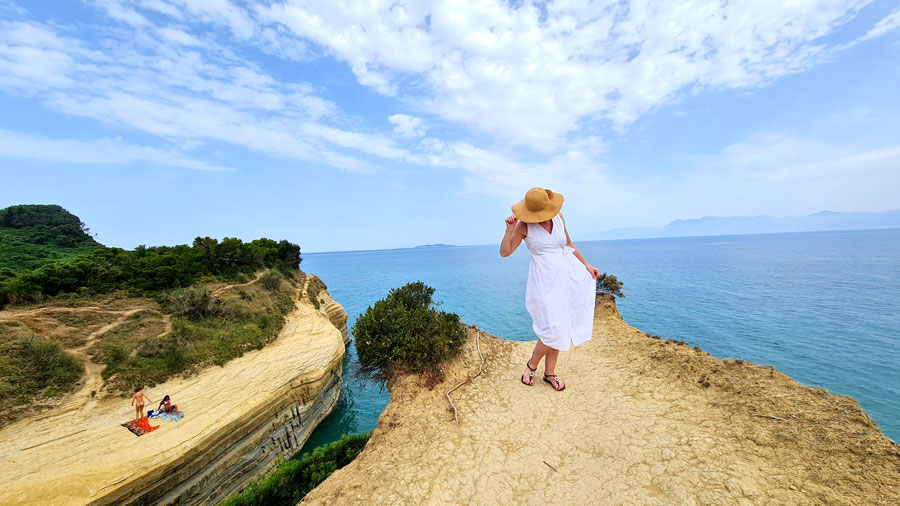
When coming to Sidari, take a few kilometers further west to reach Cape Drastis. These are the most recognizable white cliffs of Corfu Island in Greece that in some shape or form adorn all the Ionian Islands. Drive to the end of the regular road and then go on foot along the dirt road that curves down toward the sea. There is a nice spot on the way to take pictures of the Drastis cliffs.
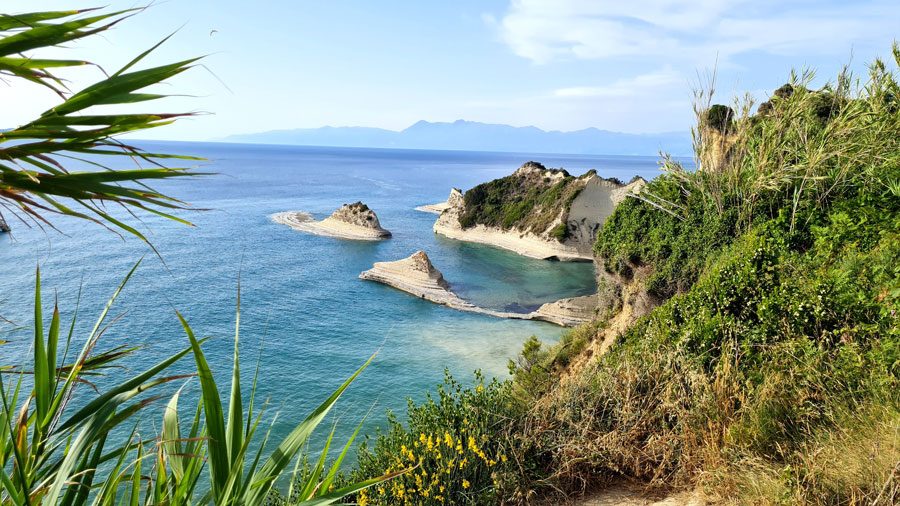
TIP: Navigation apps will take you to the foothill of the cliffs calling it a beach. It will take a 10 minute walk via a steep road to get there and it’s not a beach but a cove between rocks on the other side of Drastis. Still, it’s possible to jump and take a swim before heading back up the dirt road. A short boat tour around Drastis and Canal D’Amour can be booked here.
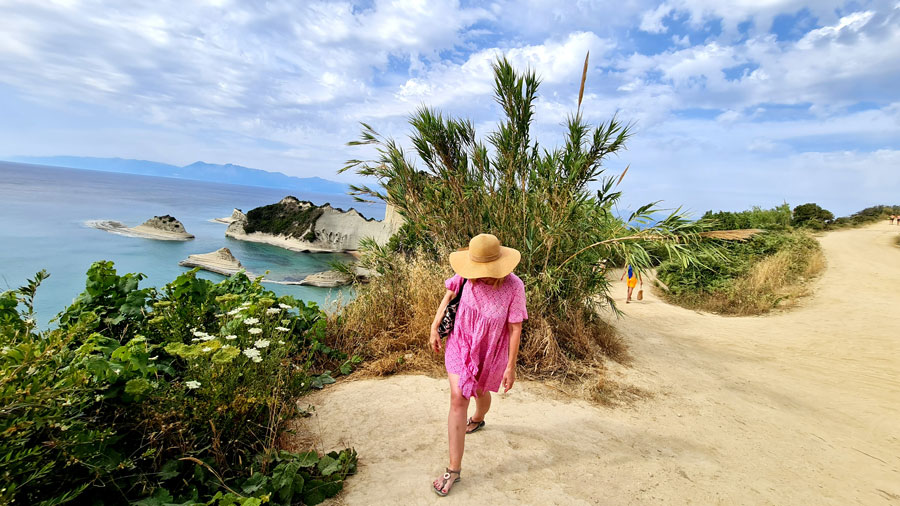
San Stefanos Corfu beach was nice at first glance. Even though on the west coast, it was covered in soft sand and flushed with mild and pleasant waves. It is not small but not very long either and one can even park a car right on the beach. Sunbeds and umbrellas can be found on both sides of the beach. Those on the left are free if you order something from the restaurants while those on the right are charged separately (€8 for a set of two sunbeds and an umbrella).
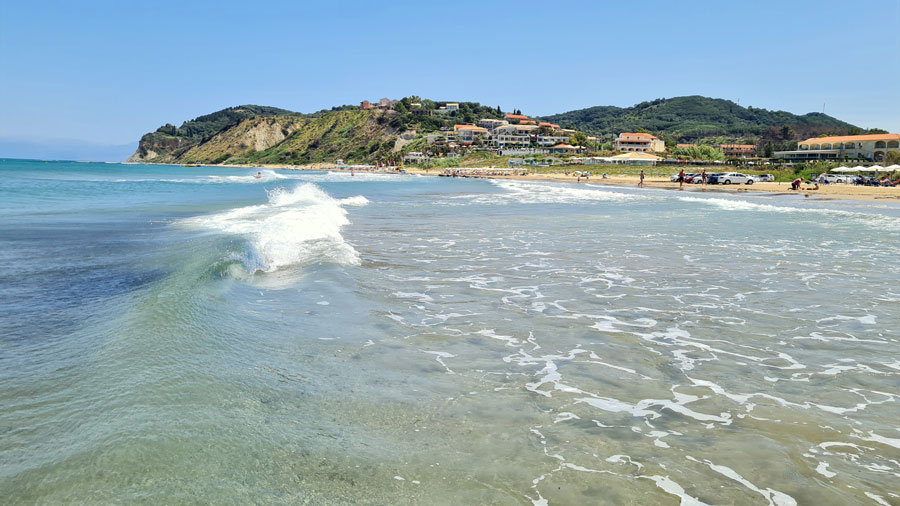
Nevertheless, the next time I came, the sea was calmer and the main disadvantage of the beach emerged. The sea was flushing out large amounts of seaweed to the shore covering the water entrance for a couple of meters along the whole beach. You have to step over it and no one seems to clean it. Since the tide comes sideways, the only part of the beach that is sea weed free is on the right (where you pay for sunbeds). The rest of the beach seems dirty even though it’s just seaweed. Elderly British couples on the left didn’t seem to mind.
TIP: I didn’t mean to sound harsh and would have to add that the food at the restaurant on the left was delicious. (On the right there were mostly sandwiches and snacks.) Try Sea Brass which is probably the cheapest on the island (€17.5 for 500 gr).
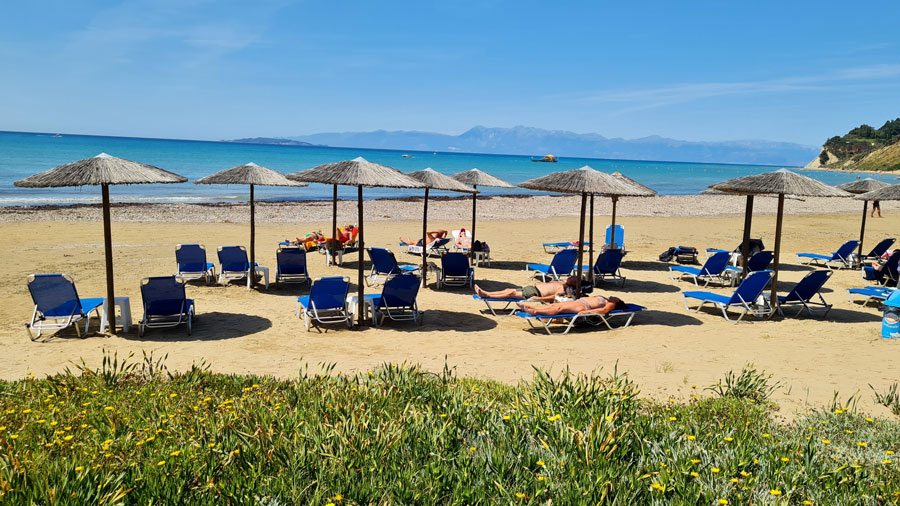
This is one of the beaches that are not easy to reach and you can’t just park next to it but is worth the effort. You can either come to the Afionas village (as I mentioned earlier) and halfway down the goat trail to the viewpoint take the turn toward the beach. (There is a small wooden sign marking the spot.) It will take about 30 minutes to reach the white sand on the opposite beaches of the “peninsula”.
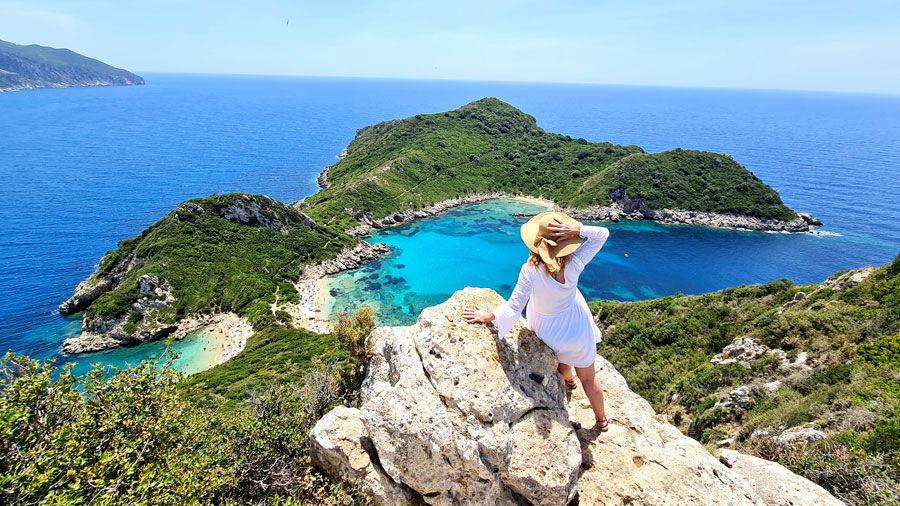
TIP: Bring an umbrella if you have one and some water and snacks because the first trace of the civilization is at least half an hour away. And try not to miss the viewpoint above given one of the best views of Corfu.
The other option is to come by boat from the nearby Agios Georgios Beach (which I will talk about next). This is a bit “lazy” and a somewhat more pleasant version but then hiking to the viewpoint will have to be put on hold for some other day.
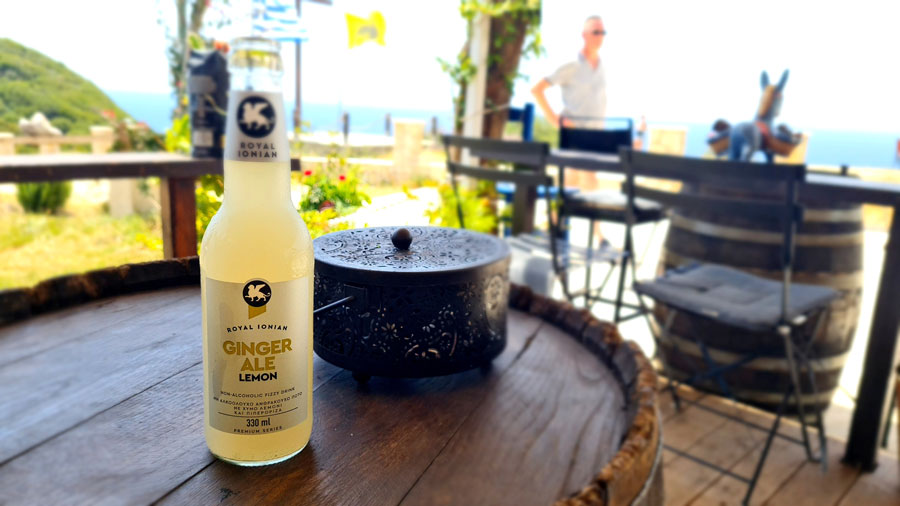
There are two St George beaches. One of them is more to the north (Agios Georgios Pagon), the other in the south (Agios Georgios Argyradon). Their names differ regarding the settlement they are situated close to but both are on the west side of the island.
Why is that so important? Because they are both home to an active sea so to speak In Pagon, the beach is mostly sandy with large stones in the water, and cafés and restaurants on the shore renting sunbeds (€8 per set). They offer all the facilities like toilet, shower, changing room, food, and drink. Still, this is probably the coldest water I found on the island! I dived in once and I could feel my brain freeze. For the next few hours, I used the shower to cool down which is extremely unusual for someone who wouldn’t get out of the sea if possible.
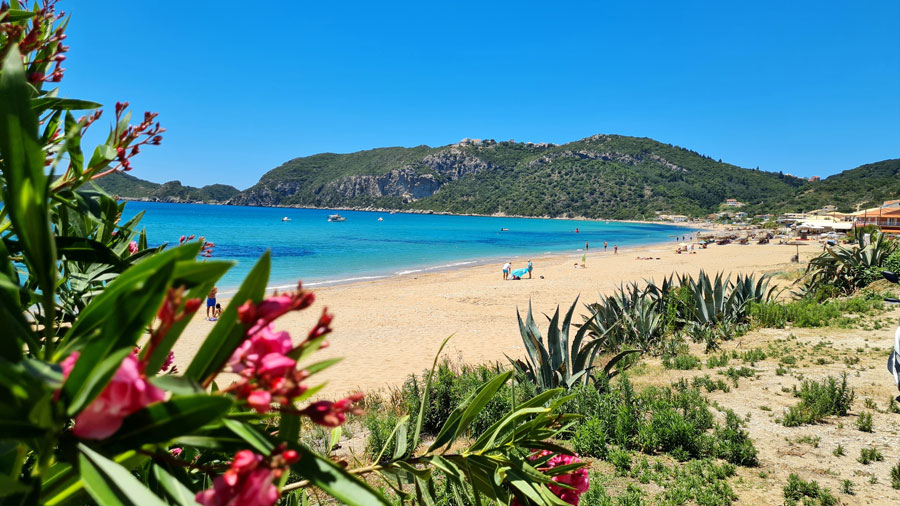
The other St George lies below Argirades town and is officially called Lakkiess Beach. This seems like a wild beach with sunbeds for rent scattered around. I liked that you can immediately notice how winds and waves sculpted the shore because there are even small dunes of sand and the vegetation grows sideways. The sand is soft, the sea warm, and the bottom has a layer of stones but this beach is wavy and windy most of the time.
TIP: If these are not your cup of tea, stop by for a short swim to check them out and move on. In my experience, neither of them deserves spending a few hours when you know how wonderful other beaches in Corfu are.
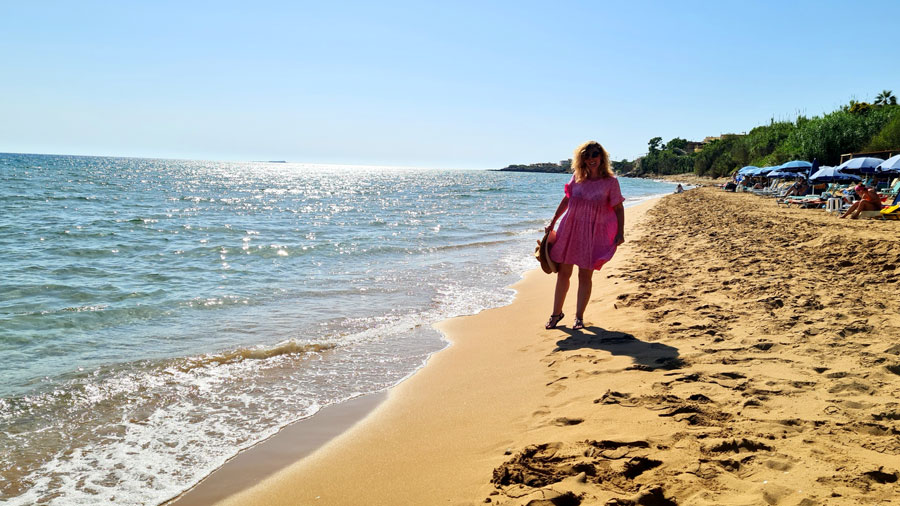
The Paleokastritsa beach is the most popular in Corfu and some say, the most beautiful. This is actually a group of a few small coves sheltered by rocks. Water gets deep pretty quickly. The sea color is beautiful due to the sand, pebbles, and stones at the bottom while the shingle covers the beach. Many get disappointed because they expect to see long bays of sand which is not the case.
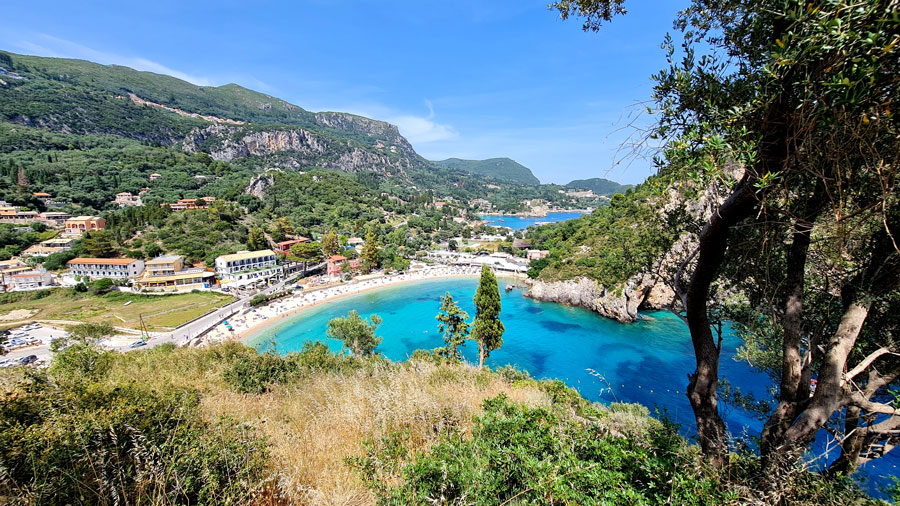
The prettiest Paleokastritsa cove is called San Spyridon Beach and is most photographed. It is situated below the hilltop Paleokastritsa Monastery. The best choice is to visit the monastery like I did and then descend downhill to have a swim. Just because it has a reputation of the prettiest one, Paleokastritsa Beach is the most expensive even though it doesn’t deserve to be. There is only one restaurant at San Spyridon Beach renting sunbeds (€25 per set). It serves nice food but not that good to differ so much from other parts of Corfu Island in Greece in regard of prices. The other part of the beach is free but can get overcrowded.
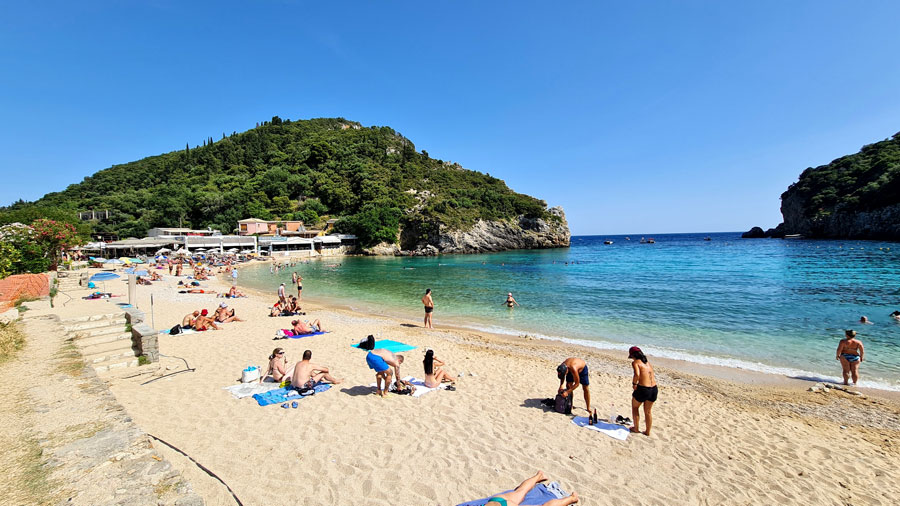
TIP: You have to come for a swim because of the lovely sea color that is pleasant and cold enough but there is no need to spend the whole day here. There is a similar (and much more relaxed) option on the eastern side, just keep reading.
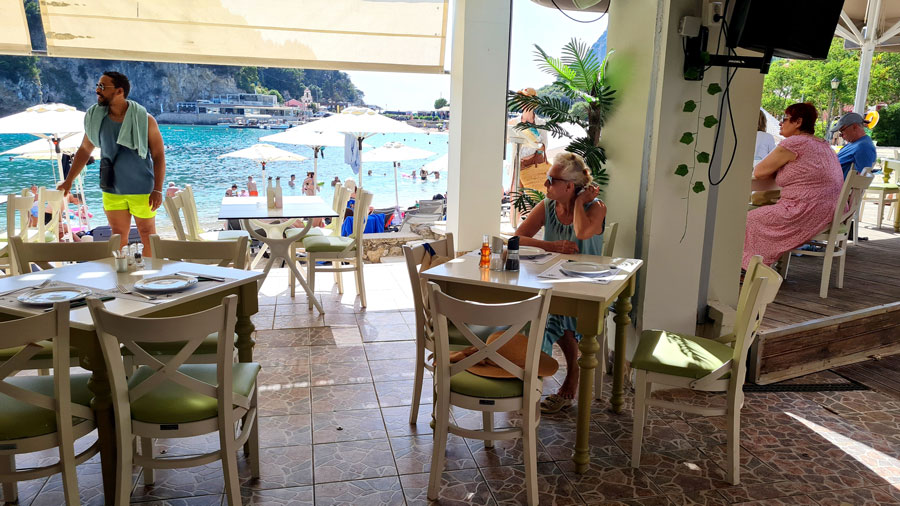
This is the last beach on the western side I visited, apart from Agios Georgios in the south. It is a good idea, for example, to combine going to Glifada with a visit to Achilleion Palace, which I did. The palace is on the opposite side but only about 15 kilometers away. You just need to cross the island to the west and enjoy the yellowish sand.
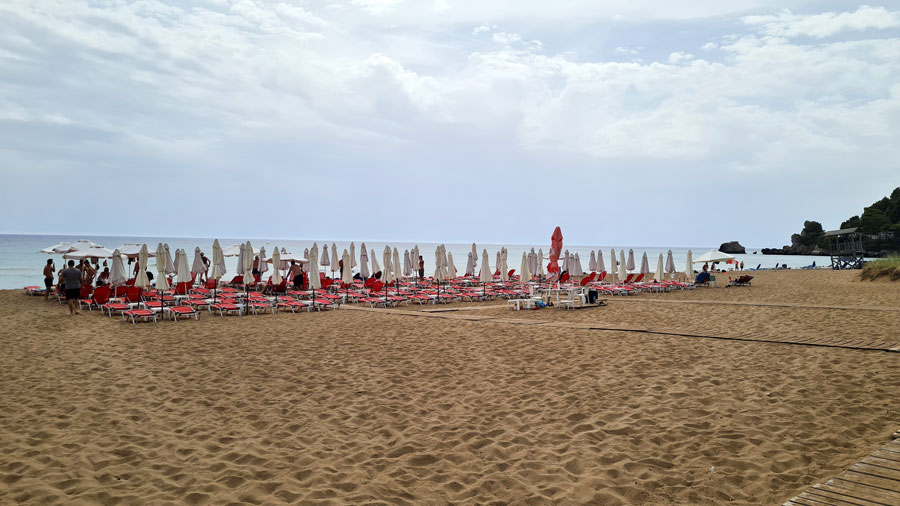
Like in other long sandy beaches (like Dasia), some parts are reserved for sunbeds owned by hotels and a beach bar with younger guests who enjoy cocktails and music. The beach is mild when it comes to sand and waves which is the reason it is popular with parents with kids. The parking is nearby. I came for a swim after all the sightseeing I did that day and dozed off with the sound of waves in the background. The last I remember seeing was the sight of a few Polish girls trying to persuade good-looking Greeks to pose for them in shallow water, right next to the sand castle some kid left on the beach. When in Corfu, right?
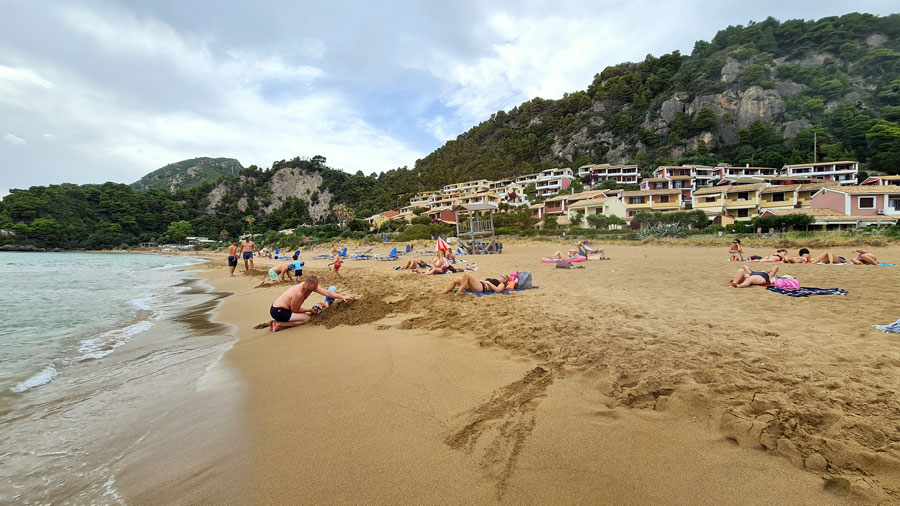
(the eastern side, from north to south)
Kassiopi is a small town on the northeastern tip of Corfu Island in Greece. If you drive along the northern coast and down the eastern side towards Corfu town, this is where all those beaches with pebbles and shingles begin. That is why the sea color is so much prettier.
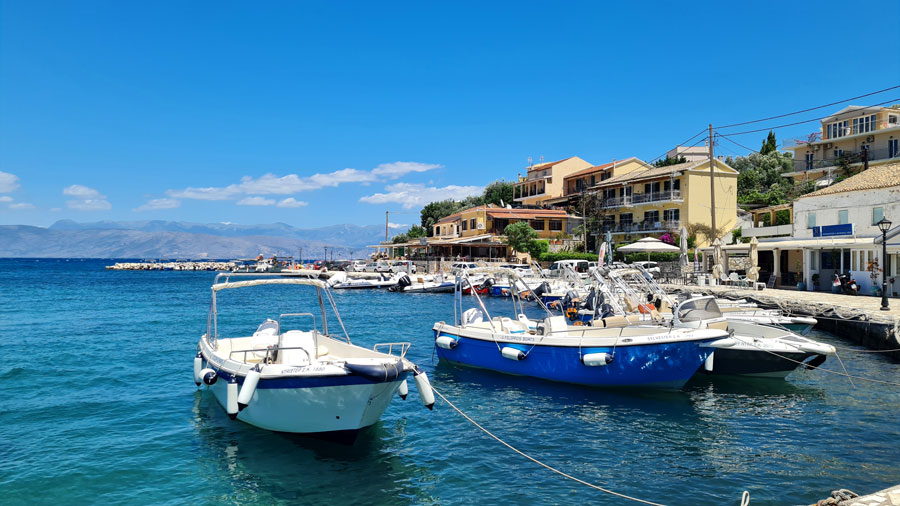
The 16th-century Byzantine fortress can be found on the hill above the settlement, one of the three in Corfu besides Angelokastro and Gardiki which were carefully placed in these three positions. Walk along the small harbor and go over to the beach. The main one is called Kalamionas but there are three lovely coves that people flock to – Batara, Kanoni, and Pipitos. Kanoni offers sunbeds scattered around the shade on the rock. Parking is improvised and narrow. Batara beach is covered with large, white pebbles and one should use shoes to go in for a swim. When I was in Kassiopi, waves were so strong (which is not that rare) that it was pretty troubling to get out of the sea. But that was an interesting experience in itself.
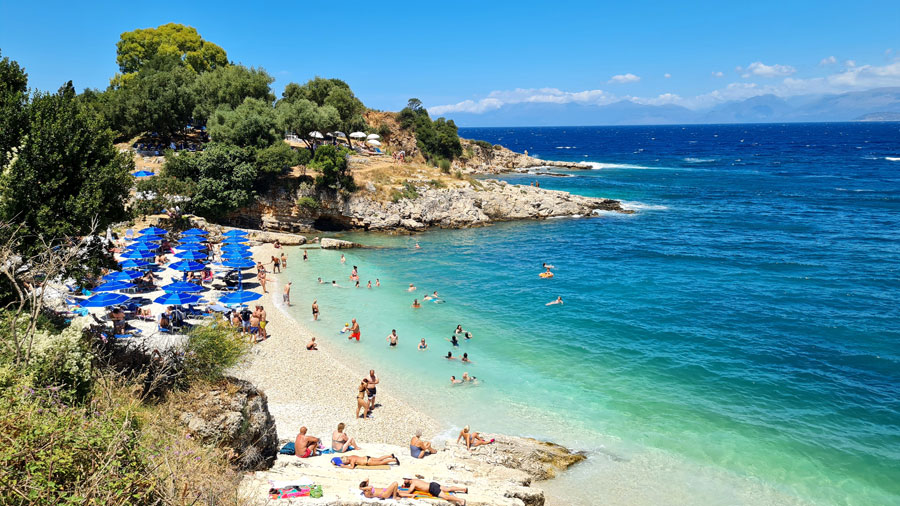
They told me to come to Avlaki because it is covered in pebbles with sunbeds for rent but less crowded than Kassiopi. I was planning on going to Kerasia Beach and Avlaki was on the way. So, I parked the car and had a short stroll. True, the beach was not crowded, there were a couple of restaurants but the waves were still too strong for my taste and I knew I had to go further down the eastern side to escape the typical northwestern wind.
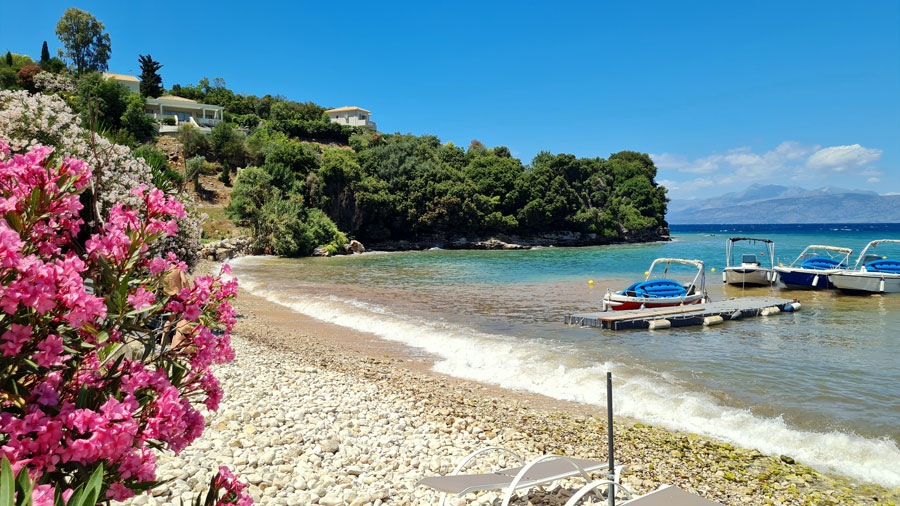
This is one of the prettiest beaches that I visited on Corfu Island in Greece. It is not typical in terms of its length, sand, or settling but is so worth a visit. The road is narrow and curvy, and very steep for the last 100 meters or so. It is only 8 kilometers from Kassiopi but will take about 20 minutes to get here. Cars are parked on the beach which is not that nice but there are not many of them. There is only one traditional restaurant and the place for drinks and snacks next door, and a single souvenir shop. Sunbeds can be rented (€8 per set).
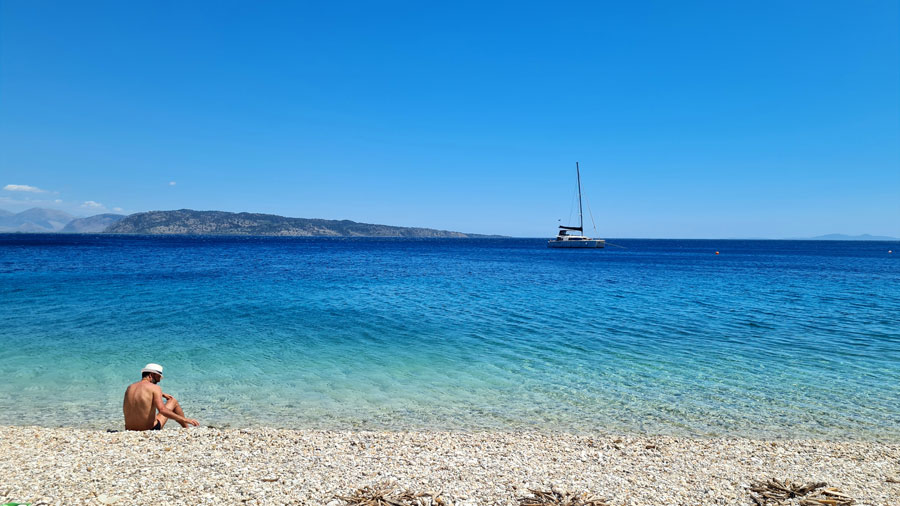
Nevertheless, the color of the water is lovely, turquoise blue, and clean, not that cold nor warm. (No waves!) If it were better equipped with beach facilities, Kerasia would be such a hit but I like the fact that it is not because it would be crowded otherwise. This way, you can always find a spot for you and the car. Swim until you get bored and have lunch with the view of the sea and no typical bustle of the large beaches.
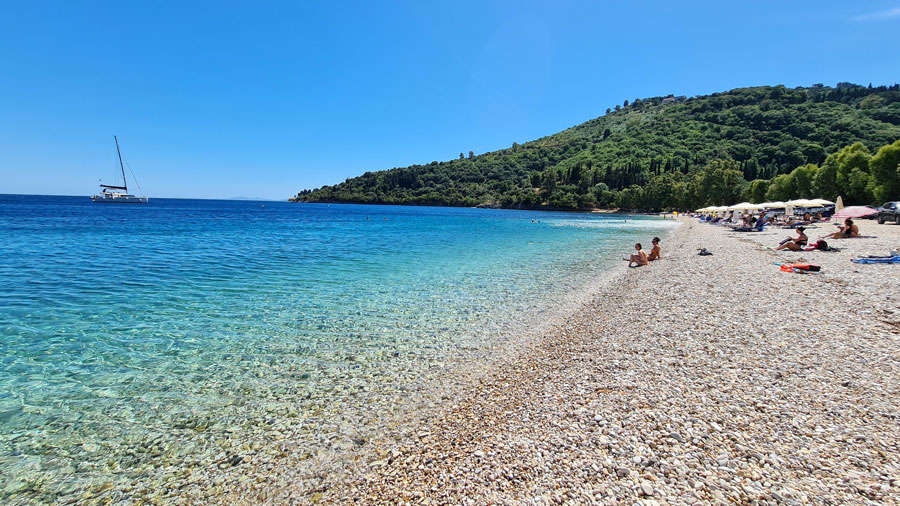
Further down to the south lies the most beautiful cove on the island. It is easily accessible but if you come from Kerasia, the narrow road curves endlessly and will take you at least half an hour to cover 15 kilometers. I was crisscrossing the island that day and came through the mountains and Agios Markos village, but the best way to come to Nissaki is from the south along the coastal road. Cars are parked along the narrow downhill road but the local café has its own small parking lot. So, I had coffee and ice cream there to take a break after the curvy drive, and went for a swim.
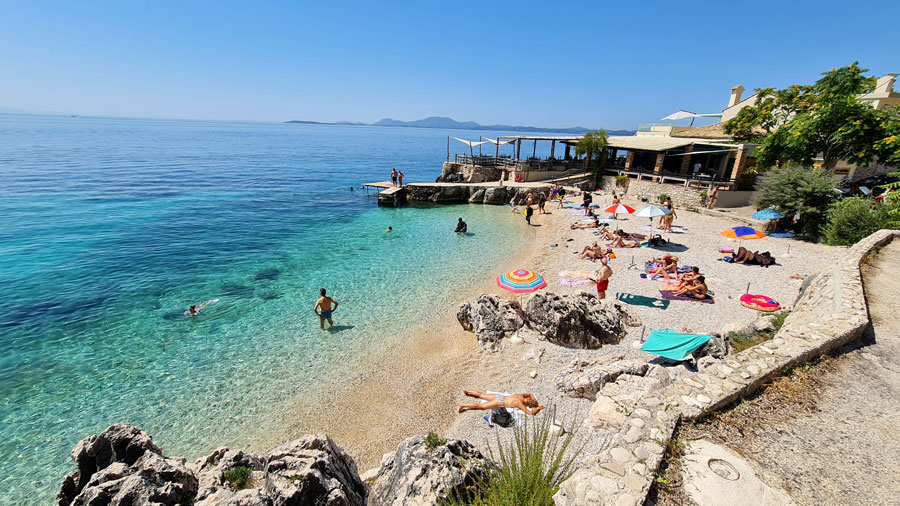
The beach is covered in shingles and is about 50 meters long. The sea is just perfect – transparent and crystal clear which is the reason a few scuba divers were just going in. There were no sunbeds to rent and people were trying to make some shade along the wall. At the very tip of the cove is a restaurant (great Shrimps!), and I think that there is only one more along with the café I mentioned, a souvenir shop, and a boat rental. There was no room for anything else.
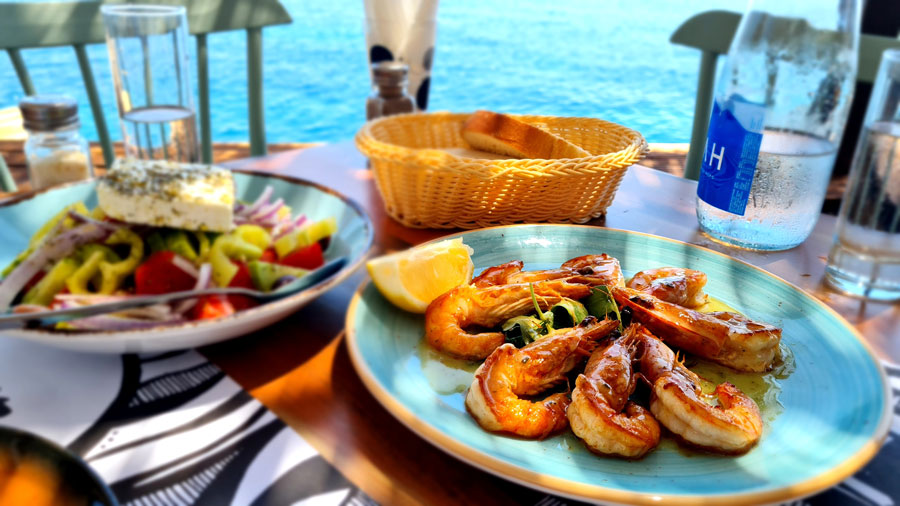
I was so mesmerized by Nissaki that I stayed here for almost the whole day and they couldn’t get me out of the sea.
TIP: Since the beach is really small, there might be no room for a single towel in the peak of the season (July and August). Your best option is to come early or around lunch. And enjoy the loveliest swim on the island!
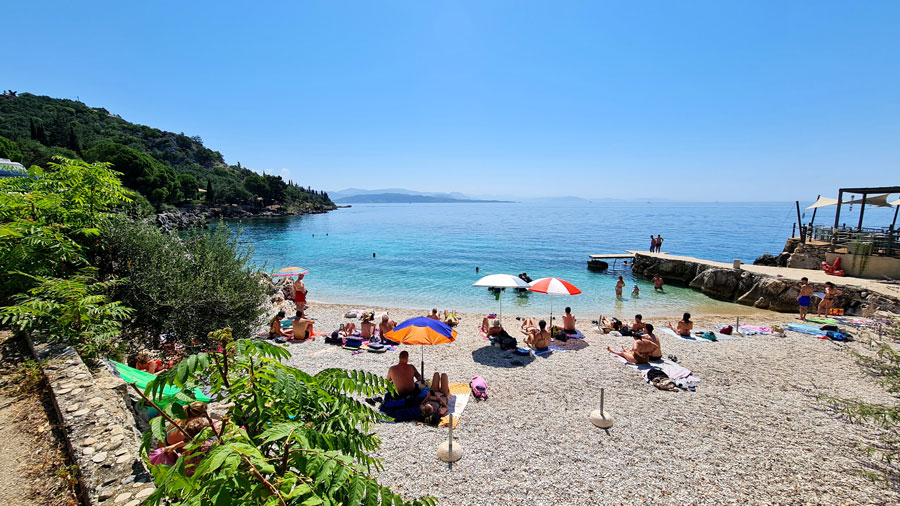
Barbati is somewhat similar to Nissaki regarding shingles and lovely sea color but it is a longer version with hotels and restaurants renting sunbeds and umbrellas for the price ranging from €10 to €20. The water is not that transparent given the number of people and the amount of activity. Still, this is the last beach with such a clear and tranquil sea when coming from the north. Beyond Barbati when going south, are the popular sandy beaches with warm and shallow water. Some of them are right by the road, some too crowded and therefore a bit dirtier with cheap old sunbeds (or too expensive if in good shape).
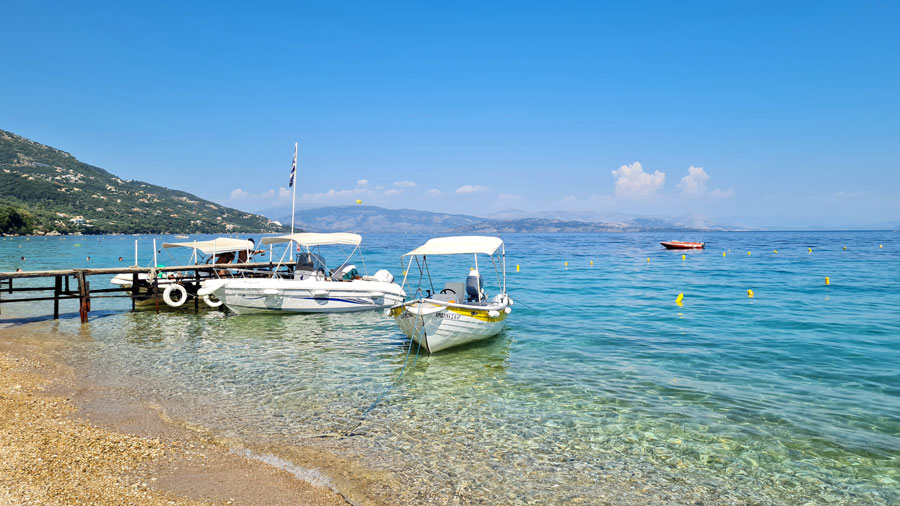
Dasia is one of the popular beaches on Corfu island in Greece partly because it is easily accessible (even the bus from the capital comes daily) and partly because it’s sandy, quiet, and shallow, thus perfect for kids and elderly couples. A large portion of the sand is owned by hotels but there are a few places to rent sunbeds or put your towel on. One of these places is accommodation but reminded me of a canteen for the British elderly who were taking a nap on the sunbeds (€4 per one plus €1 for an umbrella) while kids were restlessly diving in from the nearby platform.
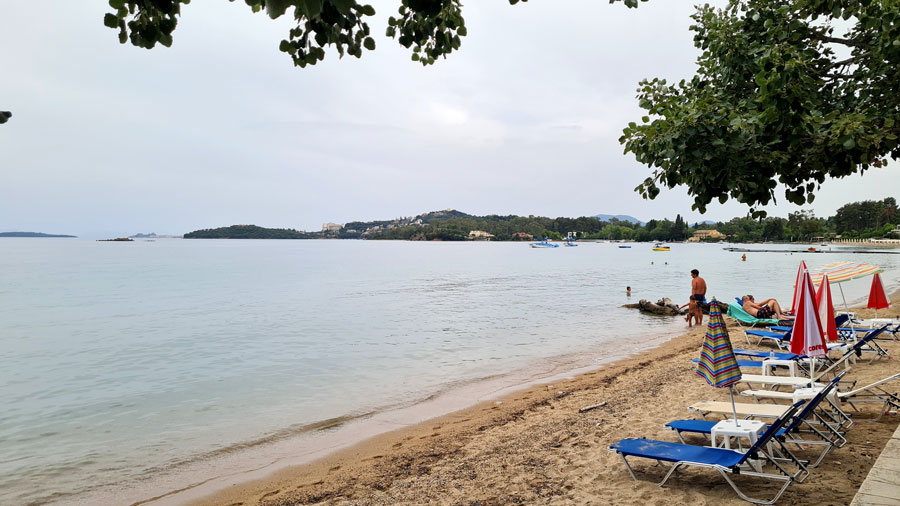
There is also the popular beach bar with the pool, parking lot, good (and expensive) sunbeds (€30 per set), and a bit of music to have a taste of a somewhat quieter beach party. Food and drinks are a little more expensive than in other restaurants.
As you may have guessed, this beach is not really up to my taste but I have to admit that the lunch pulled it off. I had a great Tuna Fillet in Ta Diktia restaurant with a nice view of the sea. Sea Bream was also delicious.
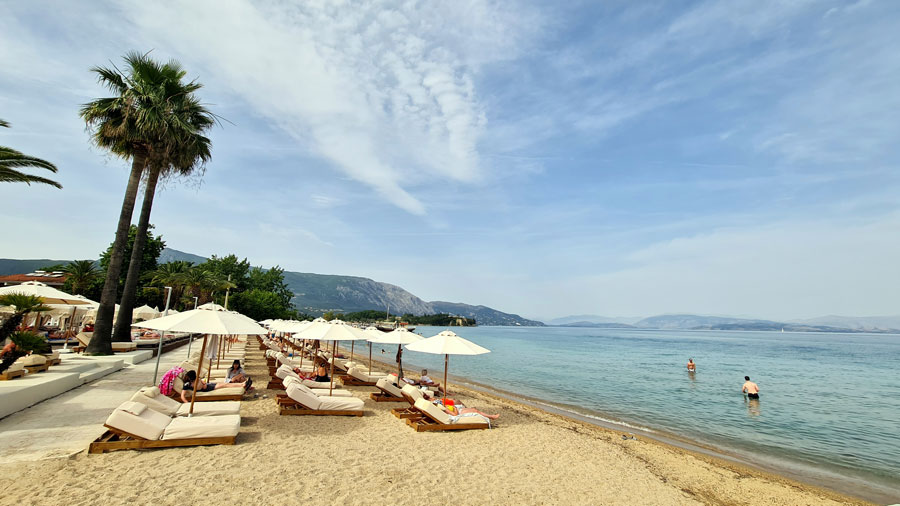
Corfu Town doesn’t really have beaches in the sense of Dasia, Benitses, or the west coast options. Still, for those who want to plunge in after a hot day of strolling around Old Town, there are a couple of places. The best one is Faliraki, a small patch of sand near the old harbor with a great view of Old Fortress and a couple of bars/restaurants. One can have lunch, drink, and sit on the concrete seafront to dry or enjoy this narrow patch of sand. One of the bars is noisier with louder music and a summer atmosphere.
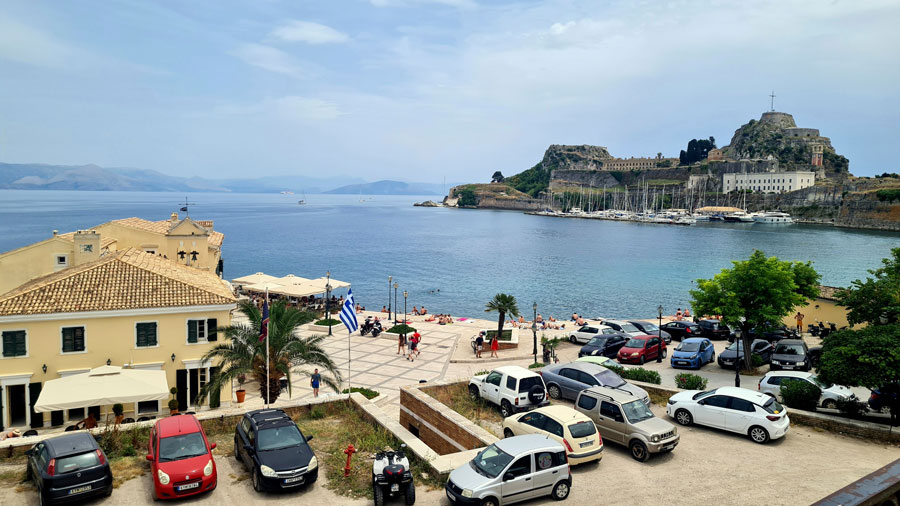
On the left when looking from above, there is another tiny beach to put your towel on. It’s right below the bustling street leading to the old port but with clear water.
They say that behind the fortress there is another small beach called Sidero but it can only be reached by boat. You will find a few more recommendations around the city regarding small patches of sand to go for a swim but they are either hard to access and find and I would rather skip them.
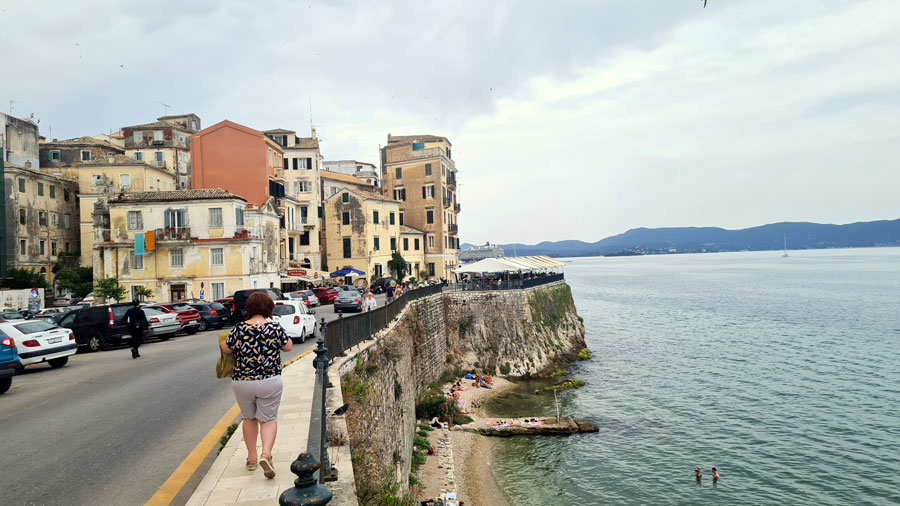
Benitses is a nice option for a beach if you want to go swimming after visiting Achilleion Palace, for example, which is situated right on the hill above. It is not that pretty but is quite easy to find. The parking lot is well marked, big enough, and free with restaurant prices lower than in Corfu town or the popular beaches. It consists of a narrow spread of sand and shingle along the road. There are two hotels and a restaurant that rent sunbeds (€20 and €10 per set). There are three partly settled and clean parts of the beach (I liked the third one best). The sea bottom is sandy with occasional rocks and seaweed.
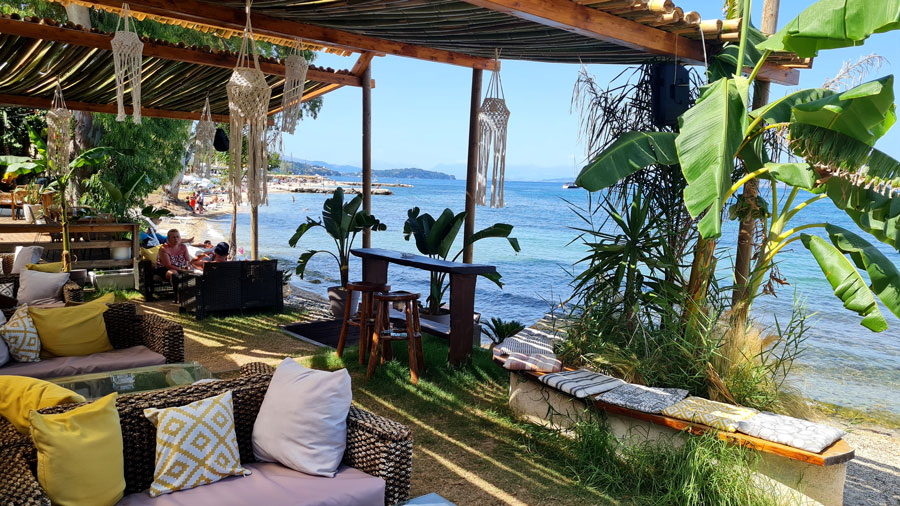
Buka Beach is only 1.5 km from Lefkimi town in the south of Corfu Island in Greece. If you plan on coming to town because of the popular canal bridge, don’t skip heading to this beach. With calm, clean, and shallow water, and no crowds, the beach is great for kids. There is one restaurant with everything you need – food, drink, shower, toilet, sunbeds, and umbrellas. If you prefer your own towel, there is plenty of room for that too.
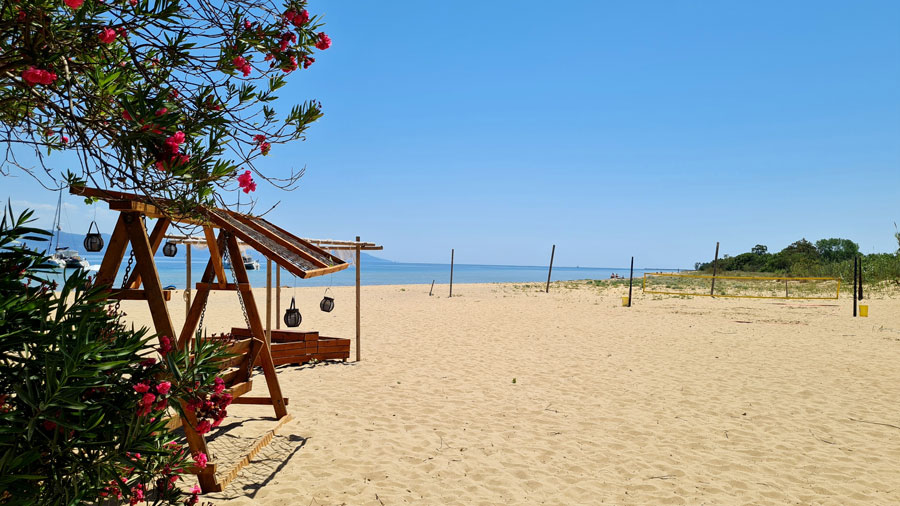
I accidentally found a great tavern a little bit to the north on the way to Messonghi. Why do I mention it? Because it is situated on the shore on the hill covered with flowers and lavish tropical vegetation which give a great shade. This all belongs to the tavern. You rent a sunbed (€4 per one) and put it in your own private part of the shade or on the rocky beach. This is not really a beach but rather a tiny cove to walk into the water gradually. The sea bottom is sandy with rocks all around the beach.

Besides that, the restaurant is immersed in lush greenery and has a beautiful view of the sea. The food is great (delicious Moussaka!) while the laidback atmosphere will allure you to spend several hours here without even noticing it. It is worth the whole afternoon because even when visited by a lot of people, you won’t have a sense of being crowded and there is always a small patch of shade waiting.
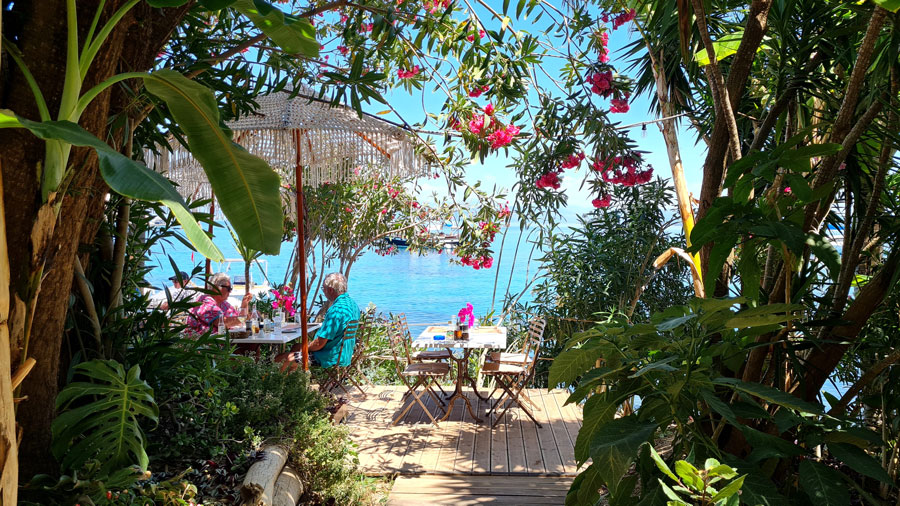
I already mentioned some dishes I tried but there should be a special section of the post dedicated to Corfu food. It’s true that you will find all those lovely Greek specialties like in any other part of the country – from Gyros, Souvlaki, Moussaka, Greek Salad, Ouzo, fresh Sea Food – but there are dishes specific for Corfu due to its heritage and influence of other cultures.
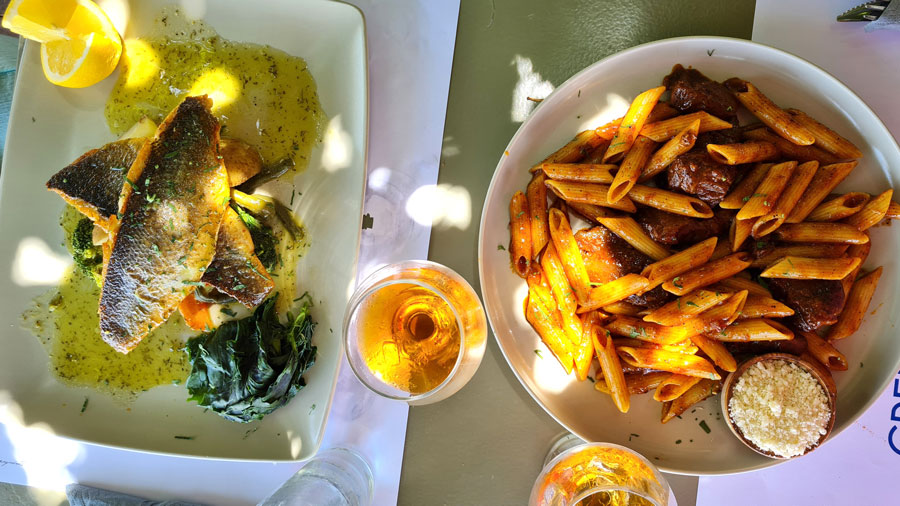
For instance, try Pastitsada which besides tender veal or rooster meat also includes (Italian) pasta. Sofrito is a slow-cooked beef in a special sauce, served with fries or rice. Bourdetto is a bit spicy dish made of fish that local fishermen couldn’t sell so they added onions and paprika and cooked it.
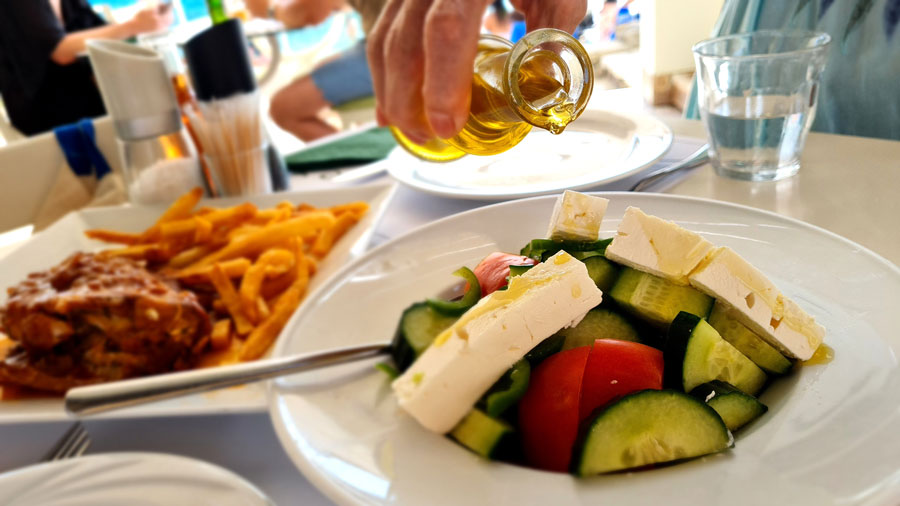
It’s not rare to find the British Fish and Chips in Corfu or Ginger Ale with various flavors but also try not to miss the popular Orange Cake or the traditional Sycomaida made of dried figs. The thing you won’t be able to miss even if you want to – in liqueurs, marmalades, cake gels, and additions to drinks – is Kumquat. This citrus fruit the size of a plum is bitter and thus rarely eaten row. The British brought it from Asia where it originates from and grows, and now it can only be found in Corfu and nowhere else in Europe.
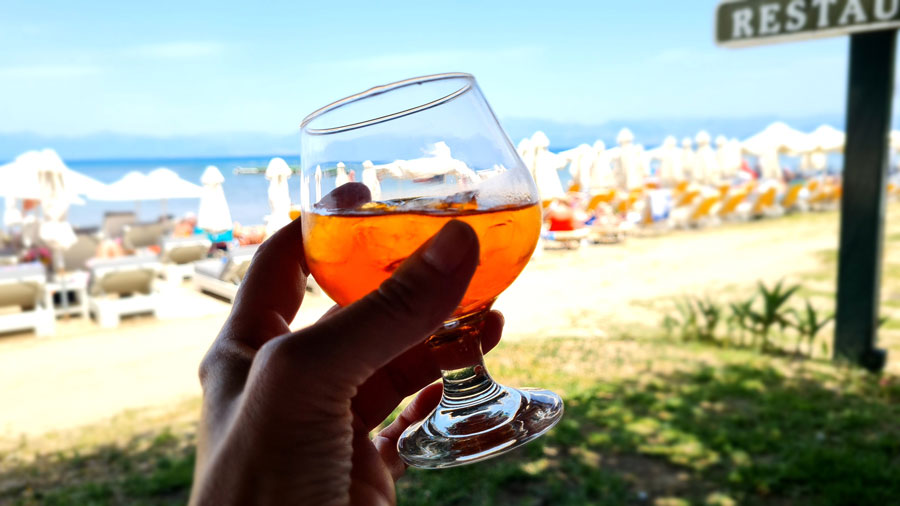
You probably know by now that I love organizing my own travels, especially if it’s this easy. Low-cost airlines fly to Corfu from different locations and I flew from Niš, Serbia. The ticket with a cabin bag was about €60 and there is an affordable parking lot where I could leave the car when coming from Belgrade.
You can find even more options when coming from other parts of Europe. Check out the flight search I provided, adjust the city you are departing from, and the dates you are interested in.
TIP: Keep in mind that flight delays or cancellations have become quite common these days. In such cases, you are always entitled to compensation, which can be up to 600 Euros per passenger. Click here to check what steps you can take if your flight is delayed.
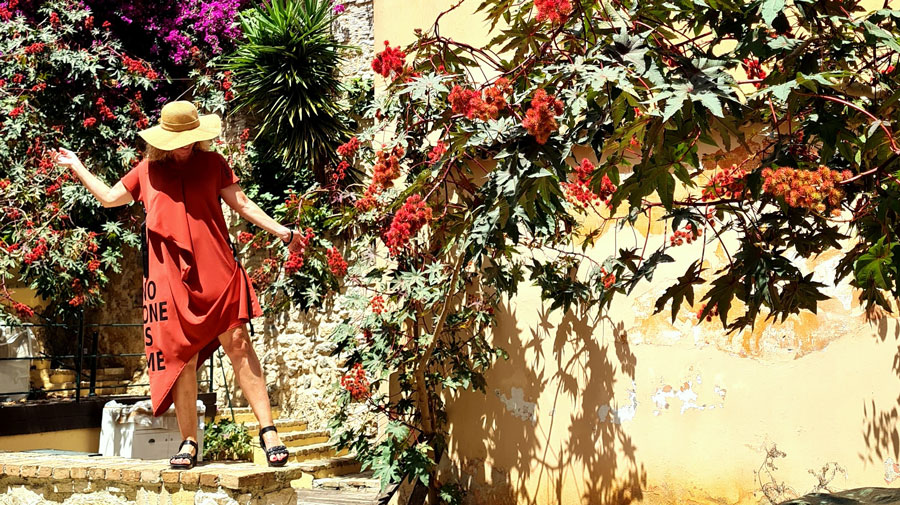
If you are planning on renting a car on Corfu Island in Greece, expect to pay almost double the amount than in other islands. I hired a car in Zakynthos less than a year ago, for example, which was twice as cheap and unlike in Corfu, with full insurance. At this link, you can check the current rental car prices and even book something for yourself.
If you’re exploring the sights and beaches on your own like I do, be sure to try using an audio guide. You can easily get one while still at home (click here), and then all that’s left is to head out and enjoy. You’ll need to download a mobile app, but the process is really simple.
As for the accommodation, it is easy to find the one according to your liking on Booking. Choose where on the island to stay depending on your preferences. You might want to be closer to beaches (click the link) or landmarks like Canal D’Amour (click to see the villa), or you prefer staying in Corfu town villas and flats. The latter option is among the most expensive and parking will be an issue but the surroundings are charming. Being in the middle of the island, like in Barbati (click for the accommodation option) is also good for touring around. (Still, I managed to go all over, even though I was staying in Sidari in the far north.)
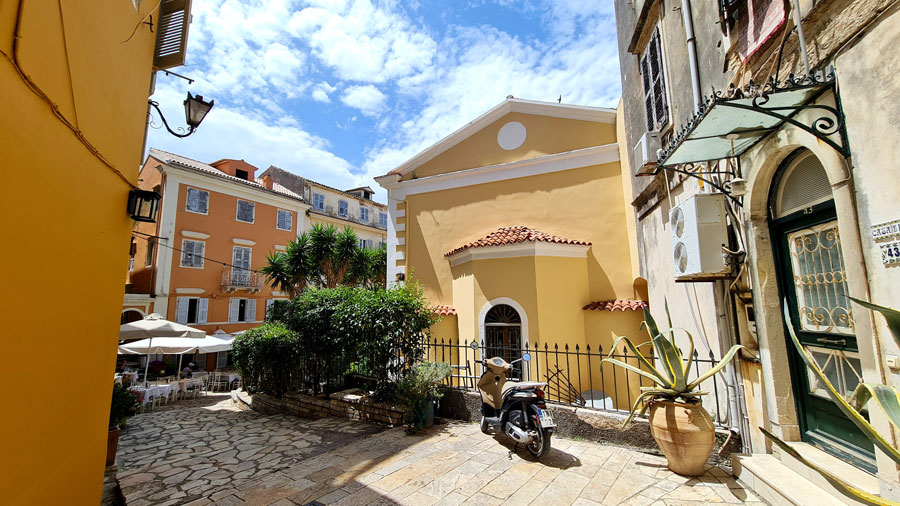
As I started writing about my stay on Corfu Island in Greece, I realized it was going to be a looong article. Still, I hope I managed to include all the things one should mention which can be useful for those planning on visiting. My journey is still fresh and just can’t seem to tell the whole story.
I am also here if you have any questions. Write a comment if you like the article whether you have the same impressions or not, or if you are still to travel to Corfu whereas my post will come in handy.
As you can see, this is going to be a great adventure!
Next: WHAT TO SEE IN ZAKYNTHOS
The full IONIAN COAST series
PIN IT FOR LATER:
If you need a freelance travel writer or you would like to see your country, city, flight, etc., presented on the blog, drop me an email.
Find our more on Freelance Travel Writer page.
I am looking forward to working with you.
